Quick filters:
Laborer 1800s Stock Photos and Images
 Workmen on the Union Pacific section of the transcontinental railroad, 1860s. Hand-colored woodcut Stock Photohttps://www.alamy.com/image-license-details/?v=1https://www.alamy.com/workmen-on-the-union-pacific-section-of-the-transcontinental-railroad-image67583143.html
Workmen on the Union Pacific section of the transcontinental railroad, 1860s. Hand-colored woodcut Stock Photohttps://www.alamy.com/image-license-details/?v=1https://www.alamy.com/workmen-on-the-union-pacific-section-of-the-transcontinental-railroad-image67583143.htmlRMDWXJYK–Workmen on the Union Pacific section of the transcontinental railroad, 1860s. Hand-colored woodcut
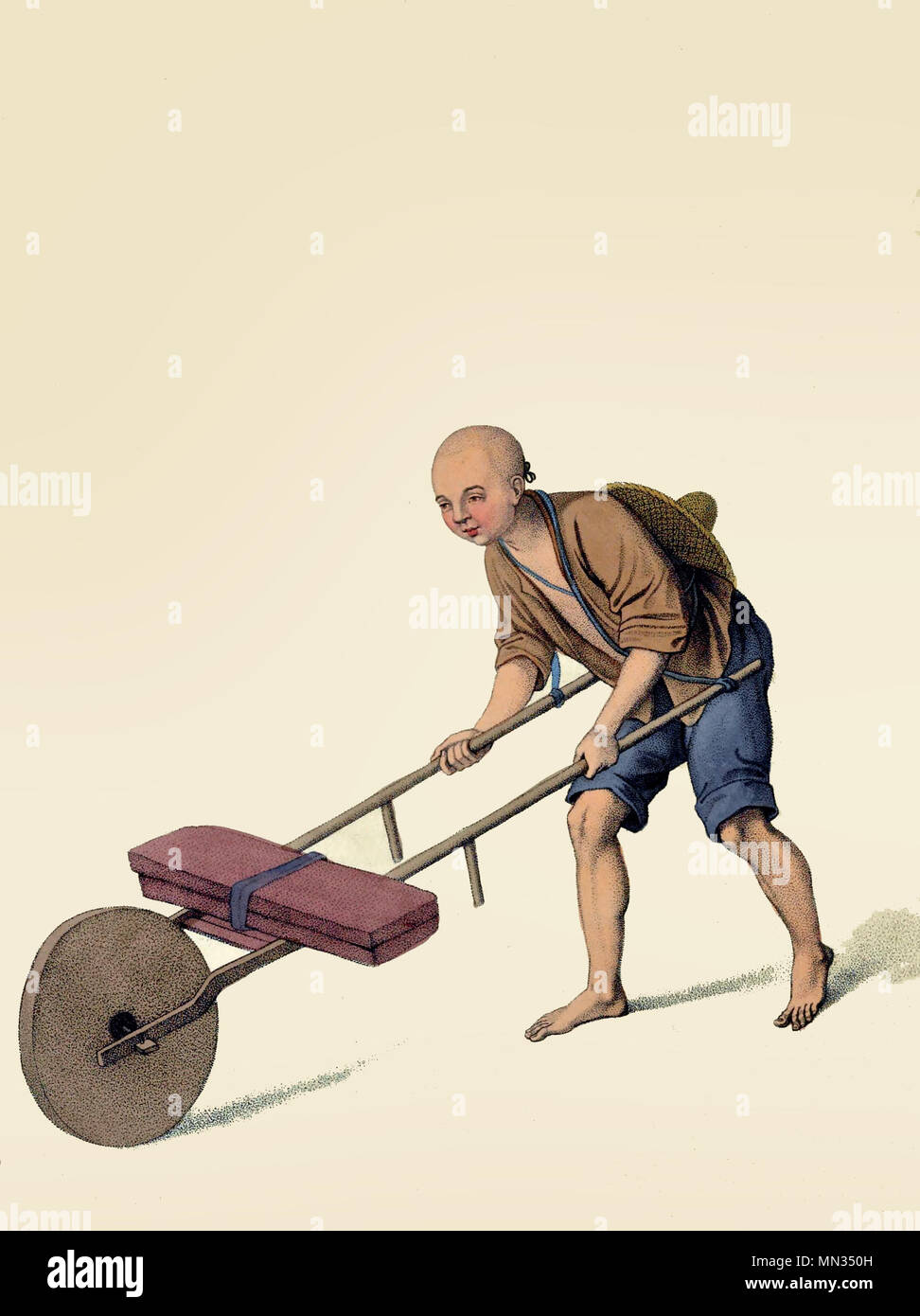 A Laborer in China, circa 1800 Stock Photohttps://www.alamy.com/image-license-details/?v=1https://www.alamy.com/a-laborer-in-china-circa-1800-image185081249.html
A Laborer in China, circa 1800 Stock Photohttps://www.alamy.com/image-license-details/?v=1https://www.alamy.com/a-laborer-in-china-circa-1800-image185081249.htmlRMMN350H–A Laborer in China, circa 1800
 Original Victorian Carte de Visite (visiting card or CDV) of working class man - a drover / shepherd wearing tall crowned bowler hat, carrying a crook, wearing leather boots with buttoned gaiters, with his faithful collie sheepdog. The man may have driven his sheep bound for the meat markets of London such as Smithfields, from as far away as Wales following ancient drovers routes. Possibly a Welshman. Many drovers grazed their animals on the Common at Peckham village before going on to London. Photographer - Theophilus Claudius Kirby (1829-1907) Peckham, S.E. London, Borough of Southwark, U.K. Stock Photohttps://www.alamy.com/image-license-details/?v=1https://www.alamy.com/original-victorian-carte-de-visite-visiting-card-or-cdv-of-working-class-man-a-drover-shepherd-wearing-tall-crowned-bowler-hat-carrying-a-crook-wearing-leather-boots-with-buttoned-gaiters-with-his-faithful-collie-sheepdog-the-man-may-have-driven-his-sheep-bound-for-the-meat-markets-of-london-such-as-smithfields-from-as-far-away-as-wales-following-ancient-drovers-routes-possibly-a-welshman-many-drovers-grazed-their-animals-on-the-common-at-peckham-village-before-going-on-to-london-photographer-theophilus-claudius-kirby-1829-1907-peckham-se-london-borough-of-southwark-uk-image597281762.html
Original Victorian Carte de Visite (visiting card or CDV) of working class man - a drover / shepherd wearing tall crowned bowler hat, carrying a crook, wearing leather boots with buttoned gaiters, with his faithful collie sheepdog. The man may have driven his sheep bound for the meat markets of London such as Smithfields, from as far away as Wales following ancient drovers routes. Possibly a Welshman. Many drovers grazed their animals on the Common at Peckham village before going on to London. Photographer - Theophilus Claudius Kirby (1829-1907) Peckham, S.E. London, Borough of Southwark, U.K. Stock Photohttps://www.alamy.com/image-license-details/?v=1https://www.alamy.com/original-victorian-carte-de-visite-visiting-card-or-cdv-of-working-class-man-a-drover-shepherd-wearing-tall-crowned-bowler-hat-carrying-a-crook-wearing-leather-boots-with-buttoned-gaiters-with-his-faithful-collie-sheepdog-the-man-may-have-driven-his-sheep-bound-for-the-meat-markets-of-london-such-as-smithfields-from-as-far-away-as-wales-following-ancient-drovers-routes-possibly-a-welshman-many-drovers-grazed-their-animals-on-the-common-at-peckham-village-before-going-on-to-london-photographer-theophilus-claudius-kirby-1829-1907-peckham-se-london-borough-of-southwark-uk-image597281762.htmlRM2WKMEYE–Original Victorian Carte de Visite (visiting card or CDV) of working class man - a drover / shepherd wearing tall crowned bowler hat, carrying a crook, wearing leather boots with buttoned gaiters, with his faithful collie sheepdog. The man may have driven his sheep bound for the meat markets of London such as Smithfields, from as far away as Wales following ancient drovers routes. Possibly a Welshman. Many drovers grazed their animals on the Common at Peckham village before going on to London. Photographer - Theophilus Claudius Kirby (1829-1907) Peckham, S.E. London, Borough of Southwark, U.K.
 This late 1800s illustration shows a Female crofter in Scotland. Crofters are people who live and work on croft land. Usually they are tenants of the person who owns the land (this is the true legal meaning of the word crofter), but, in recent times, some crofters have bought their crofts and become owner-occupiers. Crofting activities include crofting activities: cutting peat, winnowing corn, manuring fields. Stock Photohttps://www.alamy.com/image-license-details/?v=1https://www.alamy.com/this-late-1800s-illustration-shows-a-female-crofter-in-scotland-croftersare-people-who-live-and-work-on-croft-land-usually-they-are-tenants-of-the-person-who-owns-the-land-this-is-the-true-legal-meaning-of-the-wordcrofter-but-in-recent-times-somecroftershave-bought-theircroftsand-become-owner-occupiers-crofting-activities-include-crofting-activities-cutting-peat-winnowing-corn-manuring-fields-image381673975.html
This late 1800s illustration shows a Female crofter in Scotland. Crofters are people who live and work on croft land. Usually they are tenants of the person who owns the land (this is the true legal meaning of the word crofter), but, in recent times, some crofters have bought their crofts and become owner-occupiers. Crofting activities include crofting activities: cutting peat, winnowing corn, manuring fields. Stock Photohttps://www.alamy.com/image-license-details/?v=1https://www.alamy.com/this-late-1800s-illustration-shows-a-female-crofter-in-scotland-croftersare-people-who-live-and-work-on-croft-land-usually-they-are-tenants-of-the-person-who-owns-the-land-this-is-the-true-legal-meaning-of-the-wordcrofter-but-in-recent-times-somecroftershave-bought-theircroftsand-become-owner-occupiers-crofting-activities-include-crofting-activities-cutting-peat-winnowing-corn-manuring-fields-image381673975.htmlRF2D4XN1B–This late 1800s illustration shows a Female crofter in Scotland. Crofters are people who live and work on croft land. Usually they are tenants of the person who owns the land (this is the true legal meaning of the word crofter), but, in recent times, some crofters have bought their crofts and become owner-occupiers. Crofting activities include crofting activities: cutting peat, winnowing corn, manuring fields.
 Warehousing in the City by Gustave Dore Stock Photohttps://www.alamy.com/image-license-details/?v=1https://www.alamy.com/stock-photo-warehousing-in-the-city-by-gustave-dore-135089389.html
Warehousing in the City by Gustave Dore Stock Photohttps://www.alamy.com/image-license-details/?v=1https://www.alamy.com/stock-photo-warehousing-in-the-city-by-gustave-dore-135089389.htmlRMHRNRW1–Warehousing in the City by Gustave Dore
 An old engraving of farm labourers in the UK in the first half of the 1800s. It is from a Victorian history book of c.1900. During this period, agricultural work involved lots of hard work. Crops all had to be harvested by hand. Most people lived by subsistence farming. The farmers did not grow food to sell, so only sold food if they grow more than they needed. Stock Photohttps://www.alamy.com/image-license-details/?v=1https://www.alamy.com/an-old-engraving-of-farm-labourers-in-the-uk-in-the-first-half-of-the-1800s-it-is-from-a-victorian-history-book-of-c1900-during-this-period-agricultural-work-involved-lots-of-hard-work-crops-all-had-to-be-harvested-by-hand-most-people-lived-by-subsistence-farming-the-farmers-did-not-grow-food-to-sell-so-only-sold-food-if-they-grow-more-than-they-needed-image614903157.html
An old engraving of farm labourers in the UK in the first half of the 1800s. It is from a Victorian history book of c.1900. During this period, agricultural work involved lots of hard work. Crops all had to be harvested by hand. Most people lived by subsistence farming. The farmers did not grow food to sell, so only sold food if they grow more than they needed. Stock Photohttps://www.alamy.com/image-license-details/?v=1https://www.alamy.com/an-old-engraving-of-farm-labourers-in-the-uk-in-the-first-half-of-the-1800s-it-is-from-a-victorian-history-book-of-c1900-during-this-period-agricultural-work-involved-lots-of-hard-work-crops-all-had-to-be-harvested-by-hand-most-people-lived-by-subsistence-farming-the-farmers-did-not-grow-food-to-sell-so-only-sold-food-if-they-grow-more-than-they-needed-image614903157.htmlRM2XMB771–An old engraving of farm labourers in the UK in the first half of the 1800s. It is from a Victorian history book of c.1900. During this period, agricultural work involved lots of hard work. Crops all had to be harvested by hand. Most people lived by subsistence farming. The farmers did not grow food to sell, so only sold food if they grow more than they needed.
 Laborer of Quindio, Colombia. Old 19th century engraved illustration. Travel to New Granada by Charles Saffray from El Mundo en La Mano 1879 Stock Photohttps://www.alamy.com/image-license-details/?v=1https://www.alamy.com/laborer-of-quindio-colombia-old-19th-century-engraved-illustration-travel-to-new-granada-by-charles-saffray-from-el-mundo-en-la-mano-1879-image397950663.html
Laborer of Quindio, Colombia. Old 19th century engraved illustration. Travel to New Granada by Charles Saffray from El Mundo en La Mano 1879 Stock Photohttps://www.alamy.com/image-license-details/?v=1https://www.alamy.com/laborer-of-quindio-colombia-old-19th-century-engraved-illustration-travel-to-new-granada-by-charles-saffray-from-el-mundo-en-la-mano-1879-image397950663.htmlRM2E3C63K–Laborer of Quindio, Colombia. Old 19th century engraved illustration. Travel to New Granada by Charles Saffray from El Mundo en La Mano 1879
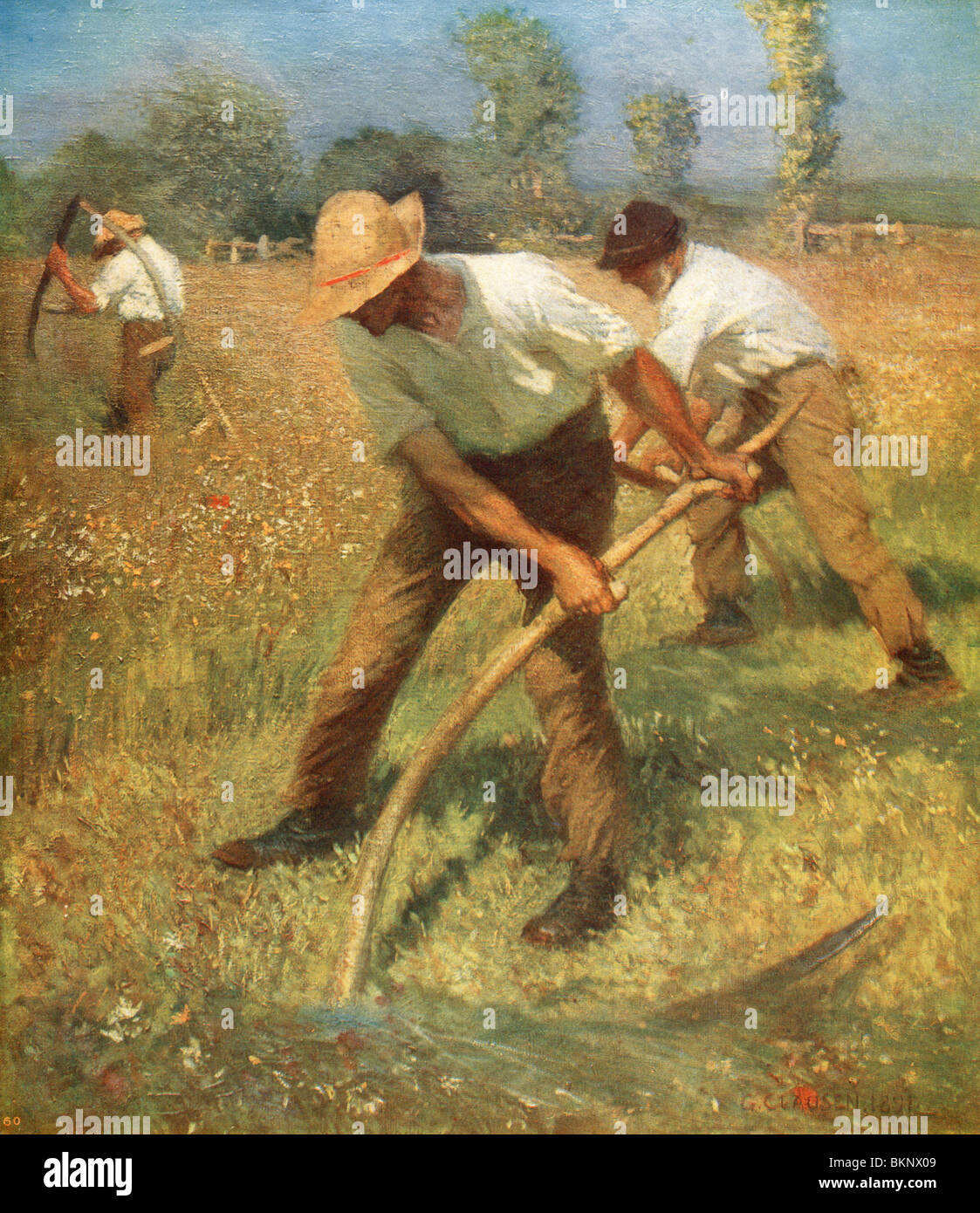 The Mowers Stock Photohttps://www.alamy.com/image-license-details/?v=1https://www.alamy.com/stock-photo-the-mowers-29370217.html
The Mowers Stock Photohttps://www.alamy.com/image-license-details/?v=1https://www.alamy.com/stock-photo-the-mowers-29370217.htmlRMBKNX09–The Mowers
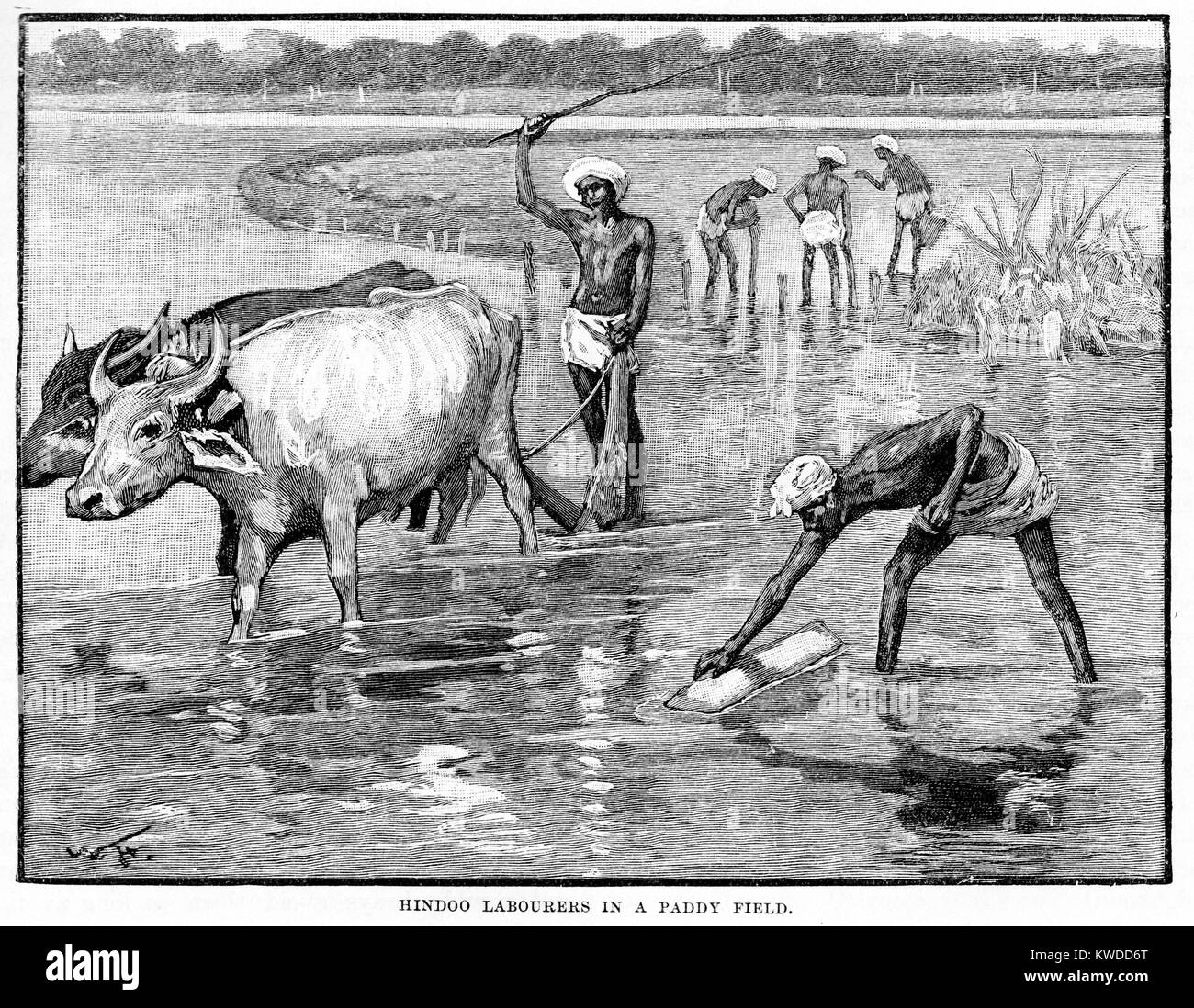 Hindu Labourers in a Paddy Field Stock Photohttps://www.alamy.com/image-license-details/?v=1https://www.alamy.com/stock-photo-hindu-labourers-in-a-paddy-field-170555472.html
Hindu Labourers in a Paddy Field Stock Photohttps://www.alamy.com/image-license-details/?v=1https://www.alamy.com/stock-photo-hindu-labourers-in-a-paddy-field-170555472.htmlRMKWDD6T–Hindu Labourers in a Paddy Field
 1700s 1800s ILLUSTRATION OF AFRICAN AMERICAN SLAVE WORKERS OPERATING COTTON GIN SOUTHERN USA Stock Photohttps://www.alamy.com/image-license-details/?v=1https://www.alamy.com/stock-photo-1700s-1800s-illustration-of-african-american-slave-workers-operating-86767907.html
1700s 1800s ILLUSTRATION OF AFRICAN AMERICAN SLAVE WORKERS OPERATING COTTON GIN SOUTHERN USA Stock Photohttps://www.alamy.com/image-license-details/?v=1https://www.alamy.com/stock-photo-1700s-1800s-illustration-of-african-american-slave-workers-operating-86767907.htmlRMF14H9R–1700s 1800s ILLUSTRATION OF AFRICAN AMERICAN SLAVE WORKERS OPERATING COTTON GIN SOUTHERN USA
 An engraving of Stradmore House, Cardiganshire scanned at high resolution from a book printed in 1812. Believed copyright free. Stock Photohttps://www.alamy.com/image-license-details/?v=1https://www.alamy.com/stock-photo-an-engraving-of-stradmore-house-cardiganshire-scanned-at-high-resolution-126995890.html
An engraving of Stradmore House, Cardiganshire scanned at high resolution from a book printed in 1812. Believed copyright free. Stock Photohttps://www.alamy.com/image-license-details/?v=1https://www.alamy.com/stock-photo-an-engraving-of-stradmore-house-cardiganshire-scanned-at-high-resolution-126995890.htmlRMHAH4FE–An engraving of Stradmore House, Cardiganshire scanned at high resolution from a book printed in 1812. Believed copyright free.
![Indian Laborers from The merchant vessel : a sailor boy's voyages to see the world [around the world] by Nordhoff, Charles, 1830-1901 engraved by C. LaPlante; some illustrations by W.L. Wyllie Publisher New York : Dodd, Mead & Co. 1884 Stock Photo Indian Laborers from The merchant vessel : a sailor boy's voyages to see the world [around the world] by Nordhoff, Charles, 1830-1901 engraved by C. LaPlante; some illustrations by W.L. Wyllie Publisher New York : Dodd, Mead & Co. 1884 Stock Photo](https://c8.alamy.com/comp/2D6XR6F/indian-laborers-from-the-merchant-vessel-a-sailor-boys-voyages-to-see-the-world-around-the-world-by-nordhoff-charles-1830-1901-engraved-by-c-laplante-some-illustrations-by-wl-wyllie-publisher-new-york-dodd-mead-co-1884-2D6XR6F.jpg) Indian Laborers from The merchant vessel : a sailor boy's voyages to see the world [around the world] by Nordhoff, Charles, 1830-1901 engraved by C. LaPlante; some illustrations by W.L. Wyllie Publisher New York : Dodd, Mead & Co. 1884 Stock Photohttps://www.alamy.com/image-license-details/?v=1https://www.alamy.com/indian-laborers-from-the-merchant-vessel-a-sailor-boys-voyages-to-see-the-world-around-the-world-by-nordhoff-charles-1830-1901-engraved-by-c-laplante-some-illustrations-by-wl-wyllie-publisher-new-york-dodd-mead-co-1884-image382904999.html
Indian Laborers from The merchant vessel : a sailor boy's voyages to see the world [around the world] by Nordhoff, Charles, 1830-1901 engraved by C. LaPlante; some illustrations by W.L. Wyllie Publisher New York : Dodd, Mead & Co. 1884 Stock Photohttps://www.alamy.com/image-license-details/?v=1https://www.alamy.com/indian-laborers-from-the-merchant-vessel-a-sailor-boys-voyages-to-see-the-world-around-the-world-by-nordhoff-charles-1830-1901-engraved-by-c-laplante-some-illustrations-by-wl-wyllie-publisher-new-york-dodd-mead-co-1884-image382904999.htmlRM2D6XR6F–Indian Laborers from The merchant vessel : a sailor boy's voyages to see the world [around the world] by Nordhoff, Charles, 1830-1901 engraved by C. LaPlante; some illustrations by W.L. Wyllie Publisher New York : Dodd, Mead & Co. 1884
 Workers fixing a 1800s steam train engine, Auckland, New Zealand Stock Photohttps://www.alamy.com/image-license-details/?v=1https://www.alamy.com/stock-photo-workers-fixing-a-1800s-steam-train-engine-auckland-new-zealand-29908619.html
Workers fixing a 1800s steam train engine, Auckland, New Zealand Stock Photohttps://www.alamy.com/image-license-details/?v=1https://www.alamy.com/stock-photo-workers-fixing-a-1800s-steam-train-engine-auckland-new-zealand-29908619.htmlRMBMJCMY–Workers fixing a 1800s steam train engine, Auckland, New Zealand
 'A little spinner in the Mollohan Mills, Newberry, S. child laborer Stock Photohttps://www.alamy.com/image-license-details/?v=1https://www.alamy.com/a-little-spinner-in-the-mollohan-mills-newberry-s-child-laborer-image615970132.html
'A little spinner in the Mollohan Mills, Newberry, S. child laborer Stock Photohttps://www.alamy.com/image-license-details/?v=1https://www.alamy.com/a-little-spinner-in-the-mollohan-mills-newberry-s-child-laborer-image615970132.htmlRM2XP3T58–'A little spinner in the Mollohan Mills, Newberry, S. child laborer
 USA, Washington State, Tacoma, Fort Nisqually Historic Site. Men in traditional 1850's laborer and dress costumes (MR) Stock Photohttps://www.alamy.com/image-license-details/?v=1https://www.alamy.com/usa-washington-state-tacoma-fort-nisqually-historic-site-men-in-traditional-image3879148.html
USA, Washington State, Tacoma, Fort Nisqually Historic Site. Men in traditional 1850's laborer and dress costumes (MR) Stock Photohttps://www.alamy.com/image-license-details/?v=1https://www.alamy.com/usa-washington-state-tacoma-fort-nisqually-historic-site-men-in-traditional-image3879148.htmlRFA7NMED–USA, Washington State, Tacoma, Fort Nisqually Historic Site. Men in traditional 1850's laborer and dress costumes (MR)
 'The Return from Toil,' drawing by John Sloan (1871-1951), published on front cover of 'The Masses', July 1913 Stock Photohttps://www.alamy.com/image-license-details/?v=1https://www.alamy.com/the-return-from-toil-drawing-by-john-sloan-1871-1951-published-on-front-cover-of-the-masses-july-1913-image484650669.html
'The Return from Toil,' drawing by John Sloan (1871-1951), published on front cover of 'The Masses', July 1913 Stock Photohttps://www.alamy.com/image-license-details/?v=1https://www.alamy.com/the-return-from-toil-drawing-by-john-sloan-1871-1951-published-on-front-cover-of-the-masses-july-1913-image484650669.htmlRM2K4DMTD–'The Return from Toil,' drawing by John Sloan (1871-1951), published on front cover of 'The Masses', July 1913
![[Construction Site]. Artist: Louis Lafon (French, active 1870s-90s). Dimensions: Image: 36.8 x 47.8 cm (14 1/2 x 18 13/16 in.). Date: 1880s. The urbanization projects of nineteenth-century France called on photography to record not only the ornamental details of a building's exterior but also the progression of its construction. Lafon mastered this type of industrial imagery, a pursuit for which he was awarded a medal at the 1874 exhibition of the Société française de photographie. This photograph succinctly captures the construction of a building that integrated modern techniques of iron and Stock Photo [Construction Site]. Artist: Louis Lafon (French, active 1870s-90s). Dimensions: Image: 36.8 x 47.8 cm (14 1/2 x 18 13/16 in.). Date: 1880s. The urbanization projects of nineteenth-century France called on photography to record not only the ornamental details of a building's exterior but also the progression of its construction. Lafon mastered this type of industrial imagery, a pursuit for which he was awarded a medal at the 1874 exhibition of the Société française de photographie. This photograph succinctly captures the construction of a building that integrated modern techniques of iron and Stock Photo](https://c8.alamy.com/comp/PAABC4/construction-site-artist-louis-lafon-french-active-1870s-90s-dimensions-image-368-x-478-cm-14-12-x-18-1316-in-date-1880s-the-urbanization-projects-of-nineteenth-century-france-called-on-photography-to-record-not-only-the-ornamental-details-of-a-buildings-exterior-but-also-the-progression-of-its-construction-lafon-mastered-this-type-of-industrial-imagery-a-pursuit-for-which-he-was-awarded-a-medal-at-the-1874-exhibition-of-the-socit-franaise-de-photographie-this-photograph-succinctly-captures-the-construction-of-a-building-that-integrated-modern-techniques-of-iron-and-PAABC4.jpg) [Construction Site]. Artist: Louis Lafon (French, active 1870s-90s). Dimensions: Image: 36.8 x 47.8 cm (14 1/2 x 18 13/16 in.). Date: 1880s. The urbanization projects of nineteenth-century France called on photography to record not only the ornamental details of a building's exterior but also the progression of its construction. Lafon mastered this type of industrial imagery, a pursuit for which he was awarded a medal at the 1874 exhibition of the Société française de photographie. This photograph succinctly captures the construction of a building that integrated modern techniques of iron and Stock Photohttps://www.alamy.com/image-license-details/?v=1https://www.alamy.com/construction-site-artist-louis-lafon-french-active-1870s-90s-dimensions-image-368-x-478-cm-14-12-x-18-1316-in-date-1880s-the-urbanization-projects-of-nineteenth-century-france-called-on-photography-to-record-not-only-the-ornamental-details-of-a-buildings-exterior-but-also-the-progression-of-its-construction-lafon-mastered-this-type-of-industrial-imagery-a-pursuit-for-which-he-was-awarded-a-medal-at-the-1874-exhibition-of-the-socit-franaise-de-photographie-this-photograph-succinctly-captures-the-construction-of-a-building-that-integrated-modern-techniques-of-iron-and-image212899460.html
[Construction Site]. Artist: Louis Lafon (French, active 1870s-90s). Dimensions: Image: 36.8 x 47.8 cm (14 1/2 x 18 13/16 in.). Date: 1880s. The urbanization projects of nineteenth-century France called on photography to record not only the ornamental details of a building's exterior but also the progression of its construction. Lafon mastered this type of industrial imagery, a pursuit for which he was awarded a medal at the 1874 exhibition of the Société française de photographie. This photograph succinctly captures the construction of a building that integrated modern techniques of iron and Stock Photohttps://www.alamy.com/image-license-details/?v=1https://www.alamy.com/construction-site-artist-louis-lafon-french-active-1870s-90s-dimensions-image-368-x-478-cm-14-12-x-18-1316-in-date-1880s-the-urbanization-projects-of-nineteenth-century-france-called-on-photography-to-record-not-only-the-ornamental-details-of-a-buildings-exterior-but-also-the-progression-of-its-construction-lafon-mastered-this-type-of-industrial-imagery-a-pursuit-for-which-he-was-awarded-a-medal-at-the-1874-exhibition-of-the-socit-franaise-de-photographie-this-photograph-succinctly-captures-the-construction-of-a-building-that-integrated-modern-techniques-of-iron-and-image212899460.htmlRMPAABC4–[Construction Site]. Artist: Louis Lafon (French, active 1870s-90s). Dimensions: Image: 36.8 x 47.8 cm (14 1/2 x 18 13/16 in.). Date: 1880s. The urbanization projects of nineteenth-century France called on photography to record not only the ornamental details of a building's exterior but also the progression of its construction. Lafon mastered this type of industrial imagery, a pursuit for which he was awarded a medal at the 1874 exhibition of the Société française de photographie. This photograph succinctly captures the construction of a building that integrated modern techniques of iron and
 Engraved illustration depicting the interior of Calvin T Sampson's shoe factory in North Adams, Massachusetts showing Chinese immigrants fastening soles onto shoes, first published in Harper's Weekly for an article relating to worker strikes and Chinese laborers, Massachusets, 1870. From the New York Public Library. Stock Photohttps://www.alamy.com/image-license-details/?v=1https://www.alamy.com/stock-image-engraved-illustration-depicting-the-interior-of-calvin-t-sampsons-166772176.html
Engraved illustration depicting the interior of Calvin T Sampson's shoe factory in North Adams, Massachusetts showing Chinese immigrants fastening soles onto shoes, first published in Harper's Weekly for an article relating to worker strikes and Chinese laborers, Massachusets, 1870. From the New York Public Library. Stock Photohttps://www.alamy.com/image-license-details/?v=1https://www.alamy.com/stock-image-engraved-illustration-depicting-the-interior-of-calvin-t-sampsons-166772176.htmlRMKK93H4–Engraved illustration depicting the interior of Calvin T Sampson's shoe factory in North Adams, Massachusetts showing Chinese immigrants fastening soles onto shoes, first published in Harper's Weekly for an article relating to worker strikes and Chinese laborers, Massachusets, 1870. From the New York Public Library.
 Woman Kneading Dough Outline Stock Photohttps://www.alamy.com/image-license-details/?v=1https://www.alamy.com/stock-image-woman-kneading-dough-outline-168986368.html
Woman Kneading Dough Outline Stock Photohttps://www.alamy.com/image-license-details/?v=1https://www.alamy.com/stock-image-woman-kneading-dough-outline-168986368.htmlRFKPWYRC–Woman Kneading Dough Outline
 Striking workers on parade in the U.S., late 1800s. Hand-colored woodcut Stock Photohttps://www.alamy.com/image-license-details/?v=1https://www.alamy.com/stock-photo-striking-workers-on-parade-in-the-us-late-1800s-hand-colored-woodcut-28512589.html
Striking workers on parade in the U.S., late 1800s. Hand-colored woodcut Stock Photohttps://www.alamy.com/image-license-details/?v=1https://www.alamy.com/stock-photo-striking-workers-on-parade-in-the-us-late-1800s-hand-colored-woodcut-28512589.htmlRMBJAT2N–Striking workers on parade in the U.S., late 1800s. Hand-colored woodcut
 The Well Driller (Le Foreur) (ca. 1873-1874) by Paul Cézanne. Stock Photohttps://www.alamy.com/image-license-details/?v=1https://www.alamy.com/the-well-driller-le-foreur-ca-1873-1874-by-paul-czanne-image454700628.html
The Well Driller (Le Foreur) (ca. 1873-1874) by Paul Cézanne. Stock Photohttps://www.alamy.com/image-license-details/?v=1https://www.alamy.com/the-well-driller-le-foreur-ca-1873-1874-by-paul-czanne-image454700628.htmlRM2HBNB84–The Well Driller (Le Foreur) (ca. 1873-1874) by Paul Cézanne.
 Original 19th century albumen print on card (small cabinet card size) probably Russian - this group of 4 working class / peasant class men are wearing typical felt boots of Russia, called Valenki, for hard work outside in the freezing cold. Circa 1880's /1890's, Russia. Stock Photohttps://www.alamy.com/image-license-details/?v=1https://www.alamy.com/original-19th-century-albumen-print-on-card-small-cabinet-card-size-probably-russian-this-group-of-4-working-class-peasant-class-men-are-wearing-typical-felt-boots-of-russia-called-valenki-for-hard-work-outside-in-the-freezing-cold-circa-1880s-1890s-russia-image463424523.html
Original 19th century albumen print on card (small cabinet card size) probably Russian - this group of 4 working class / peasant class men are wearing typical felt boots of Russia, called Valenki, for hard work outside in the freezing cold. Circa 1880's /1890's, Russia. Stock Photohttps://www.alamy.com/image-license-details/?v=1https://www.alamy.com/original-19th-century-albumen-print-on-card-small-cabinet-card-size-probably-russian-this-group-of-4-working-class-peasant-class-men-are-wearing-typical-felt-boots-of-russia-called-valenki-for-hard-work-outside-in-the-freezing-cold-circa-1880s-1890s-russia-image463424523.htmlRM2HWXPKR–Original 19th century albumen print on card (small cabinet card size) probably Russian - this group of 4 working class / peasant class men are wearing typical felt boots of Russia, called Valenki, for hard work outside in the freezing cold. Circa 1880's /1890's, Russia.
 This late 1800s illustration shows a male crofter at work in Scotland. Crofters are people who live and work on croft land. Usually they are tenants of the person who owns the land (this is the true legal meaning of the word crofter), but, in recent times, some crofters have bought their crofts and become owner-occupiers. Crofting activities include crofting activities: cutting peat, winnowing corn, manuring fields. Stock Photohttps://www.alamy.com/image-license-details/?v=1https://www.alamy.com/this-late-1800s-illustration-shows-a-male-crofter-at-work-in-scotland-croftersare-people-who-live-and-work-on-croft-land-usually-they-are-tenants-of-the-person-who-owns-the-land-this-is-the-true-legal-meaning-of-the-wordcrofter-but-in-recent-times-somecroftershave-bought-theircroftsand-become-owner-occupiers-crofting-activities-include-crofting-activities-cutting-peat-winnowing-corn-manuring-fields-image381673981.html
This late 1800s illustration shows a male crofter at work in Scotland. Crofters are people who live and work on croft land. Usually they are tenants of the person who owns the land (this is the true legal meaning of the word crofter), but, in recent times, some crofters have bought their crofts and become owner-occupiers. Crofting activities include crofting activities: cutting peat, winnowing corn, manuring fields. Stock Photohttps://www.alamy.com/image-license-details/?v=1https://www.alamy.com/this-late-1800s-illustration-shows-a-male-crofter-at-work-in-scotland-croftersare-people-who-live-and-work-on-croft-land-usually-they-are-tenants-of-the-person-who-owns-the-land-this-is-the-true-legal-meaning-of-the-wordcrofter-but-in-recent-times-somecroftershave-bought-theircroftsand-become-owner-occupiers-crofting-activities-include-crofting-activities-cutting-peat-winnowing-corn-manuring-fields-image381673981.htmlRF2D4XN1H–This late 1800s illustration shows a male crofter at work in Scotland. Crofters are people who live and work on croft land. Usually they are tenants of the person who owns the land (this is the true legal meaning of the word crofter), but, in recent times, some crofters have bought their crofts and become owner-occupiers. Crofting activities include crofting activities: cutting peat, winnowing corn, manuring fields.
 Art Nouveau artwork on gable of large Neo-Renaissance, Belle Epoque (late 19th century / early 20th century) building on Alšovo Square in Písek, South Bohemia, Czechia. The artwork depicts a working man holding a pickaxe and an oil lamp, possibly a miner. Stock Photohttps://www.alamy.com/image-license-details/?v=1https://www.alamy.com/art-nouveau-artwork-on-gable-of-large-neo-renaissance-belle-epoque-late-19th-century-early-20th-century-building-on-alovo-square-in-psek-south-bohemia-czechia-the-artwork-depicts-a-working-man-holding-a-pickaxe-and-an-oil-lamp-possibly-a-miner-image569600651.html
Art Nouveau artwork on gable of large Neo-Renaissance, Belle Epoque (late 19th century / early 20th century) building on Alšovo Square in Písek, South Bohemia, Czechia. The artwork depicts a working man holding a pickaxe and an oil lamp, possibly a miner. Stock Photohttps://www.alamy.com/image-license-details/?v=1https://www.alamy.com/art-nouveau-artwork-on-gable-of-large-neo-renaissance-belle-epoque-late-19th-century-early-20th-century-building-on-alovo-square-in-psek-south-bohemia-czechia-the-artwork-depicts-a-working-man-holding-a-pickaxe-and-an-oil-lamp-possibly-a-miner-image569600651.htmlRF2T2KFCB–Art Nouveau artwork on gable of large Neo-Renaissance, Belle Epoque (late 19th century / early 20th century) building on Alšovo Square in Písek, South Bohemia, Czechia. The artwork depicts a working man holding a pickaxe and an oil lamp, possibly a miner.
 An old engraving of ‘tramps’ in Ireland in the mid-1800s. It is from a Victorian history book of c.1900. While vagrancy was a criminal offence in its own right, poverty was often associated with forms of criminality and immorality that meant ‘tramps’ were often viewed with prejudice. Itinerant people were viewed with suspicion and prejudice, not on account of their poverty, but rather because many viewed them as making travelling the country as a lifestyle choice. Stock Photohttps://www.alamy.com/image-license-details/?v=1https://www.alamy.com/an-old-engraving-of-tramps-in-ireland-in-the-mid-1800s-it-is-from-a-victorian-history-book-of-c1900-while-vagrancy-was-a-criminal-offence-in-its-own-right-poverty-was-often-associated-with-forms-of-criminality-and-immorality-that-meant-tramps-were-often-viewed-with-prejudice-itinerant-people-were-viewed-with-suspicion-and-prejudice-not-on-account-of-their-poverty-but-rather-because-many-viewed-them-as-making-travelling-the-country-as-a-lifestyle-choice-image614903251.html
An old engraving of ‘tramps’ in Ireland in the mid-1800s. It is from a Victorian history book of c.1900. While vagrancy was a criminal offence in its own right, poverty was often associated with forms of criminality and immorality that meant ‘tramps’ were often viewed with prejudice. Itinerant people were viewed with suspicion and prejudice, not on account of their poverty, but rather because many viewed them as making travelling the country as a lifestyle choice. Stock Photohttps://www.alamy.com/image-license-details/?v=1https://www.alamy.com/an-old-engraving-of-tramps-in-ireland-in-the-mid-1800s-it-is-from-a-victorian-history-book-of-c1900-while-vagrancy-was-a-criminal-offence-in-its-own-right-poverty-was-often-associated-with-forms-of-criminality-and-immorality-that-meant-tramps-were-often-viewed-with-prejudice-itinerant-people-were-viewed-with-suspicion-and-prejudice-not-on-account-of-their-poverty-but-rather-because-many-viewed-them-as-making-travelling-the-country-as-a-lifestyle-choice-image614903251.htmlRM2XMB7AB–An old engraving of ‘tramps’ in Ireland in the mid-1800s. It is from a Victorian history book of c.1900. While vagrancy was a criminal offence in its own right, poverty was often associated with forms of criminality and immorality that meant ‘tramps’ were often viewed with prejudice. Itinerant people were viewed with suspicion and prejudice, not on account of their poverty, but rather because many viewed them as making travelling the country as a lifestyle choice.
 Laborer of Quindio, Colombia. Old 19th century engraved illustration. Travel to New Granada by Charles Saffray from El Mundo en La Mano 1879 Stock Photohttps://www.alamy.com/image-license-details/?v=1https://www.alamy.com/laborer-of-quindio-colombia-old-19th-century-engraved-illustration-travel-to-new-granada-by-charles-saffray-from-el-mundo-en-la-mano-1879-image387551773.html
Laborer of Quindio, Colombia. Old 19th century engraved illustration. Travel to New Granada by Charles Saffray from El Mundo en La Mano 1879 Stock Photohttps://www.alamy.com/image-license-details/?v=1https://www.alamy.com/laborer-of-quindio-colombia-old-19th-century-engraved-illustration-travel-to-new-granada-by-charles-saffray-from-el-mundo-en-la-mano-1879-image387551773.htmlRM2DEEE6N–Laborer of Quindio, Colombia. Old 19th century engraved illustration. Travel to New Granada by Charles Saffray from El Mundo en La Mano 1879
 Decorative Trade Card Stock Photohttps://www.alamy.com/image-license-details/?v=1https://www.alamy.com/stock-photo-decorative-trade-card-30072184.html
Decorative Trade Card Stock Photohttps://www.alamy.com/image-license-details/?v=1https://www.alamy.com/stock-photo-decorative-trade-card-30072184.htmlRMBMWWAG–Decorative Trade Card
 Nuttall & Co Country Store, 6495 Ware Neck Road, Gloucester Courthouse, Virginia Stock Photohttps://www.alamy.com/image-license-details/?v=1https://www.alamy.com/stock-image-nuttall-co-country-store-6495-ware-neck-road-gloucester-courthouse-162328920.html
Nuttall & Co Country Store, 6495 Ware Neck Road, Gloucester Courthouse, Virginia Stock Photohttps://www.alamy.com/image-license-details/?v=1https://www.alamy.com/stock-image-nuttall-co-country-store-6495-ware-neck-road-gloucester-courthouse-162328920.htmlRMKC2M5C–Nuttall & Co Country Store, 6495 Ware Neck Road, Gloucester Courthouse, Virginia
 A Fellah woman Fellah is a peasant, usually a farmer or agricultural laborer in the Middle East and North Africa. The word derives from the Arabic word for 'ploughman' or 'tiller'. From the book The living races of mankind; Volume 2 by Henry Neville Hutchinson, Published in London in 1901 by Hutchinson & co Stock Photohttps://www.alamy.com/image-license-details/?v=1https://www.alamy.com/a-fellah-woman-fellah-is-a-peasant-usually-a-farmer-or-agricultural-laborer-in-the-middle-east-and-north-africa-the-word-derives-from-the-arabic-word-for-ploughman-or-tiller-from-the-book-the-living-races-of-mankind-volume-2-by-henry-neville-hutchinson-published-in-london-in-1901-by-hutchinson-co-image461161873.html
A Fellah woman Fellah is a peasant, usually a farmer or agricultural laborer in the Middle East and North Africa. The word derives from the Arabic word for 'ploughman' or 'tiller'. From the book The living races of mankind; Volume 2 by Henry Neville Hutchinson, Published in London in 1901 by Hutchinson & co Stock Photohttps://www.alamy.com/image-license-details/?v=1https://www.alamy.com/a-fellah-woman-fellah-is-a-peasant-usually-a-farmer-or-agricultural-laborer-in-the-middle-east-and-north-africa-the-word-derives-from-the-arabic-word-for-ploughman-or-tiller-from-the-book-the-living-races-of-mankind-volume-2-by-henry-neville-hutchinson-published-in-london-in-1901-by-hutchinson-co-image461161873.htmlRF2HP7MJW–A Fellah woman Fellah is a peasant, usually a farmer or agricultural laborer in the Middle East and North Africa. The word derives from the Arabic word for 'ploughman' or 'tiller'. From the book The living races of mankind; Volume 2 by Henry Neville Hutchinson, Published in London in 1901 by Hutchinson & co
 'The Return from Toil,' drawing by John Sloan (1871-1951), published on front cover of 'The Masses', July 1913 Stock Photohttps://www.alamy.com/image-license-details/?v=1https://www.alamy.com/the-return-from-toil-drawing-by-john-sloan-1871-1951-published-on-front-cover-of-the-masses-july-1913-image484999536.html
'The Return from Toil,' drawing by John Sloan (1871-1951), published on front cover of 'The Masses', July 1913 Stock Photohttps://www.alamy.com/image-license-details/?v=1https://www.alamy.com/the-return-from-toil-drawing-by-john-sloan-1871-1951-published-on-front-cover-of-the-masses-july-1913-image484999536.htmlRM2K51HT0–'The Return from Toil,' drawing by John Sloan (1871-1951), published on front cover of 'The Masses', July 1913
 Caucasian Woman Kneading Dough on Table Stock Photohttps://www.alamy.com/image-license-details/?v=1https://www.alamy.com/stock-image-caucasian-woman-kneading-dough-on-table-168986369.html
Caucasian Woman Kneading Dough on Table Stock Photohttps://www.alamy.com/image-license-details/?v=1https://www.alamy.com/stock-image-caucasian-woman-kneading-dough-on-table-168986369.htmlRFKPWYRD–Caucasian Woman Kneading Dough on Table
 Construction of the Northern Pacific Railway to Puget Sound, Washington State, late 1800s. Engraving Stock Photohttps://www.alamy.com/image-license-details/?v=1https://www.alamy.com/construction-of-the-northern-pacific-railway-to-puget-sound-washington-image67583156.html
Construction of the Northern Pacific Railway to Puget Sound, Washington State, late 1800s. Engraving Stock Photohttps://www.alamy.com/image-license-details/?v=1https://www.alamy.com/construction-of-the-northern-pacific-railway-to-puget-sound-washington-image67583156.htmlRMDWXK04–Construction of the Northern Pacific Railway to Puget Sound, Washington State, late 1800s. Engraving
 Original Victorian cabinet card portrait of a working class man wearing a flat cap, an ill-fitting suit, with too short sleeves, turned up collar, tie, taken outside with a canvas backdrop against a stone wall - late 1880's, early 1890's, U.K. Stock Photohttps://www.alamy.com/image-license-details/?v=1https://www.alamy.com/original-victorian-cabinet-card-portrait-of-a-working-class-man-wearing-a-flat-cap-an-ill-fitting-suit-with-too-short-sleeves-turned-up-collar-tie-taken-outside-with-a-canvas-backdrop-against-a-stone-wall-late-1880s-early-1890s-uk-image461581210.html
Original Victorian cabinet card portrait of a working class man wearing a flat cap, an ill-fitting suit, with too short sleeves, turned up collar, tie, taken outside with a canvas backdrop against a stone wall - late 1880's, early 1890's, U.K. Stock Photohttps://www.alamy.com/image-license-details/?v=1https://www.alamy.com/original-victorian-cabinet-card-portrait-of-a-working-class-man-wearing-a-flat-cap-an-ill-fitting-suit-with-too-short-sleeves-turned-up-collar-tie-taken-outside-with-a-canvas-backdrop-against-a-stone-wall-late-1880s-early-1890s-uk-image461581210.htmlRM2HPXRF6–Original Victorian cabinet card portrait of a working class man wearing a flat cap, an ill-fitting suit, with too short sleeves, turned up collar, tie, taken outside with a canvas backdrop against a stone wall - late 1880's, early 1890's, U.K.
 An old engraving of a man at work to provide irrigation water to his fruit trees in southern California, USA in the 1800s. It is from an American history book of 1895. Using stone-lined ditches and wooden sluices, the Spanish missionaries were the first to redirect water from natural flowing streams and rivers to provide water to gardens and fields that surrounded the early Missions in the state. The California Gold Rush during the mid-1800s saw an increase in farming in order to provide food for the population explosion during the boom years. Stock Photohttps://www.alamy.com/image-license-details/?v=1https://www.alamy.com/an-old-engraving-of-a-man-at-work-to-provide-irrigation-water-to-his-fruit-trees-in-southern-california-usa-in-the-1800s-it-is-from-an-american-history-book-of-1895-using-stone-lined-ditches-and-wooden-sluices-the-spanish-missionaries-were-the-first-to-redirect-water-from-natural-flowing-streams-and-rivers-to-provide-water-to-gardens-and-fields-that-surrounded-the-early-missions-in-the-state-the-california-gold-rush-during-the-mid-1800s-saw-an-increase-in-farming-in-order-to-provide-food-for-the-population-explosion-during-the-boom-years-image560920129.html
An old engraving of a man at work to provide irrigation water to his fruit trees in southern California, USA in the 1800s. It is from an American history book of 1895. Using stone-lined ditches and wooden sluices, the Spanish missionaries were the first to redirect water from natural flowing streams and rivers to provide water to gardens and fields that surrounded the early Missions in the state. The California Gold Rush during the mid-1800s saw an increase in farming in order to provide food for the population explosion during the boom years. Stock Photohttps://www.alamy.com/image-license-details/?v=1https://www.alamy.com/an-old-engraving-of-a-man-at-work-to-provide-irrigation-water-to-his-fruit-trees-in-southern-california-usa-in-the-1800s-it-is-from-an-american-history-book-of-1895-using-stone-lined-ditches-and-wooden-sluices-the-spanish-missionaries-were-the-first-to-redirect-water-from-natural-flowing-streams-and-rivers-to-provide-water-to-gardens-and-fields-that-surrounded-the-early-missions-in-the-state-the-california-gold-rush-during-the-mid-1800s-saw-an-increase-in-farming-in-order-to-provide-food-for-the-population-explosion-during-the-boom-years-image560920129.htmlRM2RGG39N–An old engraving of a man at work to provide irrigation water to his fruit trees in southern California, USA in the 1800s. It is from an American history book of 1895. Using stone-lined ditches and wooden sluices, the Spanish missionaries were the first to redirect water from natural flowing streams and rivers to provide water to gardens and fields that surrounded the early Missions in the state. The California Gold Rush during the mid-1800s saw an increase in farming in order to provide food for the population explosion during the boom years.
 Man working the Docks Stock Photohttps://www.alamy.com/image-license-details/?v=1https://www.alamy.com/stock-photo-man-working-the-docks-30073086.html
Man working the Docks Stock Photohttps://www.alamy.com/image-license-details/?v=1https://www.alamy.com/stock-photo-man-working-the-docks-30073086.htmlRMBMWXEP–Man working the Docks
 Nuttall & Co Country Store, 6495 Ware Neck Road, Gloucester Courthouse, Virginia Stock Photohttps://www.alamy.com/image-license-details/?v=1https://www.alamy.com/stock-image-nuttall-co-country-store-6495-ware-neck-road-gloucester-courthouse-162328922.html
Nuttall & Co Country Store, 6495 Ware Neck Road, Gloucester Courthouse, Virginia Stock Photohttps://www.alamy.com/image-license-details/?v=1https://www.alamy.com/stock-image-nuttall-co-country-store-6495-ware-neck-road-gloucester-courthouse-162328922.htmlRMKC2M5E–Nuttall & Co Country Store, 6495 Ware Neck Road, Gloucester Courthouse, Virginia
 Interior of Tomioka Silk Mill (Joshu Tomioka seishi-jo no zu), Artist Ichiyōsai (Utagawa) Kuniteru II,Year 1872 Stock Photohttps://www.alamy.com/image-license-details/?v=1https://www.alamy.com/interior-of-tomioka-silk-mill-joshu-tomioka-seishi-jo-no-zu-artist-ichiysai-utagawa-kuniteru-iiyear-1872-image482647111.html
Interior of Tomioka Silk Mill (Joshu Tomioka seishi-jo no zu), Artist Ichiyōsai (Utagawa) Kuniteru II,Year 1872 Stock Photohttps://www.alamy.com/image-license-details/?v=1https://www.alamy.com/interior-of-tomioka-silk-mill-joshu-tomioka-seishi-jo-no-zu-artist-ichiysai-utagawa-kuniteru-iiyear-1872-image482647111.htmlRM2K16D8R–Interior of Tomioka Silk Mill (Joshu Tomioka seishi-jo no zu), Artist Ichiyōsai (Utagawa) Kuniteru II,Year 1872
 Woman Kneading Dough Stock Photohttps://www.alamy.com/image-license-details/?v=1https://www.alamy.com/stock-image-woman-kneading-dough-168986367.html
Woman Kneading Dough Stock Photohttps://www.alamy.com/image-license-details/?v=1https://www.alamy.com/stock-image-woman-kneading-dough-168986367.htmlRFKPWYRB–Woman Kneading Dough
 Steamboats lined up for freight at the levee, New Orleans, late 1800s. Hand-colored woodcut Stock Photohttps://www.alamy.com/image-license-details/?v=1https://www.alamy.com/stock-photo-steamboats-lined-up-for-freight-at-the-levee-new-orleans-late-1800s-58700293.html
Steamboats lined up for freight at the levee, New Orleans, late 1800s. Hand-colored woodcut Stock Photohttps://www.alamy.com/image-license-details/?v=1https://www.alamy.com/stock-photo-steamboats-lined-up-for-freight-at-the-levee-new-orleans-late-1800s-58700293.htmlRMDBE0R1–Steamboats lined up for freight at the levee, New Orleans, late 1800s. Hand-colored woodcut
 Shoveling coal in the cab of a steam locomotive at night, 1800s. Hand-colored woodcut Stock Photohttps://www.alamy.com/image-license-details/?v=1https://www.alamy.com/shoveling-coal-in-the-cab-of-a-steam-locomotive-at-night-1800s-hand-colored-woodcut-image188779531.html
Shoveling coal in the cab of a steam locomotive at night, 1800s. Hand-colored woodcut Stock Photohttps://www.alamy.com/image-license-details/?v=1https://www.alamy.com/shoveling-coal-in-the-cab-of-a-steam-locomotive-at-night-1800s-hand-colored-woodcut-image188779531.htmlRMMY3J63–Shoveling coal in the cab of a steam locomotive at night, 1800s. Hand-colored woodcut
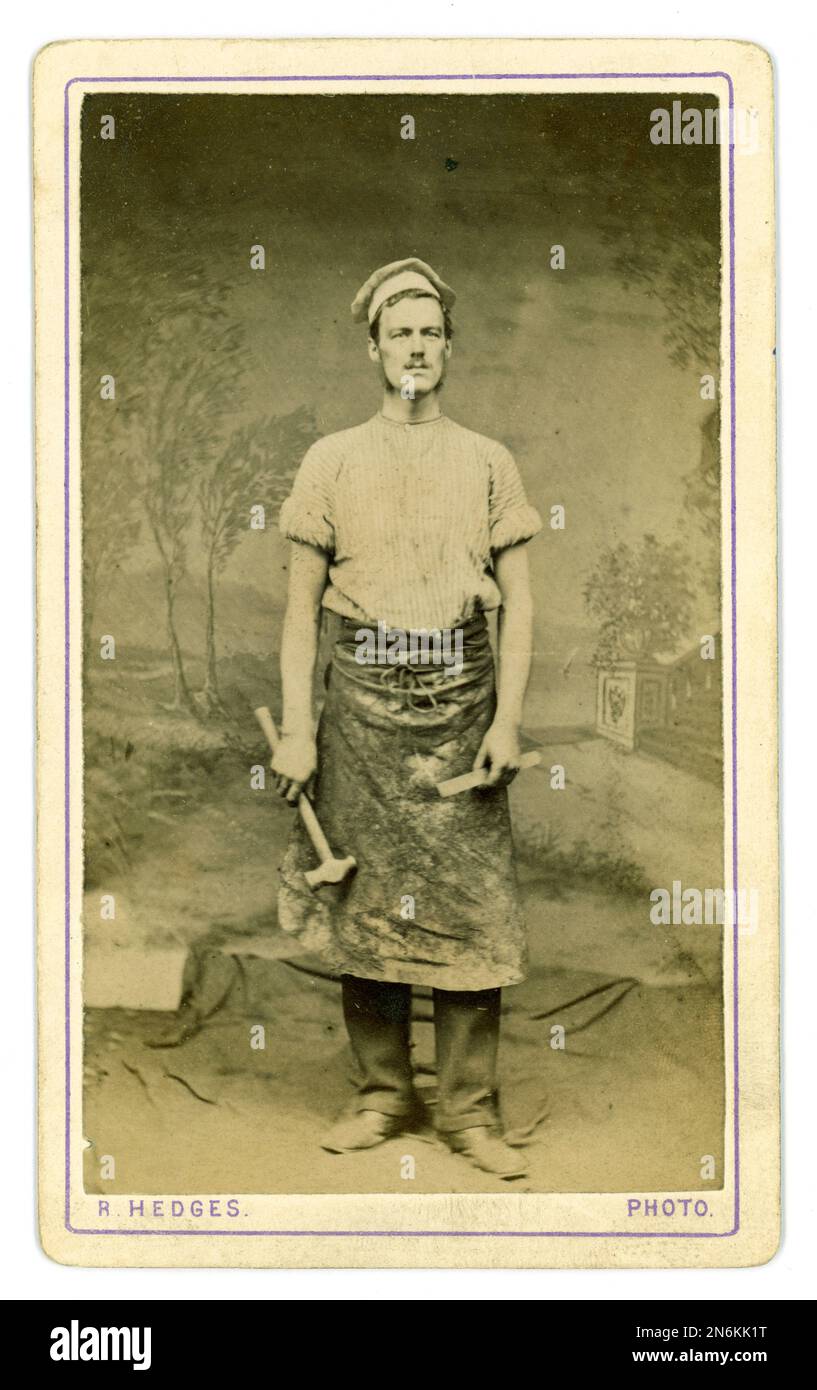 Original sepia toned Victorian era CDV (carte de visite or visiting card) of young working class man in working clothes, wearing a toque hat like a chef's, tradesman, labourer, carpenter or mason with tools, hammer, apron and cap. R Hedges 279 High Street, Camden Town, London, circa 1878. Stock Photohttps://www.alamy.com/image-license-details/?v=1https://www.alamy.com/original-sepia-toned-victorian-era-cdv-carte-de-visite-or-visiting-card-of-young-working-class-man-in-working-clothes-wearing-a-toque-hat-like-a-chefs-tradesman-labourer-carpenter-or-mason-with-tools-hammer-apron-and-cap-r-hedges-279-high-street-camden-town-london-circa-1878-image520431012.html
Original sepia toned Victorian era CDV (carte de visite or visiting card) of young working class man in working clothes, wearing a toque hat like a chef's, tradesman, labourer, carpenter or mason with tools, hammer, apron and cap. R Hedges 279 High Street, Camden Town, London, circa 1878. Stock Photohttps://www.alamy.com/image-license-details/?v=1https://www.alamy.com/original-sepia-toned-victorian-era-cdv-carte-de-visite-or-visiting-card-of-young-working-class-man-in-working-clothes-wearing-a-toque-hat-like-a-chefs-tradesman-labourer-carpenter-or-mason-with-tools-hammer-apron-and-cap-r-hedges-279-high-street-camden-town-london-circa-1878-image520431012.htmlRM2N6KK1T–Original sepia toned Victorian era CDV (carte de visite or visiting card) of young working class man in working clothes, wearing a toque hat like a chef's, tradesman, labourer, carpenter or mason with tools, hammer, apron and cap. R Hedges 279 High Street, Camden Town, London, circa 1878.
 Workers meeting at the center of the St Gotthard Railway Tunnel through the Swiss Alps, 1880. Hand-colored woodcut Stock Photohttps://www.alamy.com/image-license-details/?v=1https://www.alamy.com/workers-meeting-at-the-center-of-the-st-gotthard-railway-tunnel-through-image67583282.html
Workers meeting at the center of the St Gotthard Railway Tunnel through the Swiss Alps, 1880. Hand-colored woodcut Stock Photohttps://www.alamy.com/image-license-details/?v=1https://www.alamy.com/workers-meeting-at-the-center-of-the-st-gotthard-railway-tunnel-through-image67583282.htmlRMDWXK4J–Workers meeting at the center of the St Gotthard Railway Tunnel through the Swiss Alps, 1880. Hand-colored woodcut
 An old engraving of agricultural gang of women and children working on a farm in the 1800s. It is from a Victorian history book of c.1900. One small child looks to have been taken ill or suffering from exhaustion. Agricultural gangs were groups of women, girls and boys organised by an independent gang-master, under whose supervision they executed agricultural piece-work for farmers in certain parts of England for a payment negotiated between the gangmaster and farmer. Much suffering resulted from a nomadic life and the poor treatment by gangmasters, often involving long hours for poor pay. Stock Photohttps://www.alamy.com/image-license-details/?v=1https://www.alamy.com/an-old-engraving-of-agricultural-gang-of-women-and-children-working-on-a-farm-in-the-1800s-it-is-from-a-victorian-history-book-of-c1900-one-small-child-looks-to-have-been-taken-ill-or-suffering-from-exhaustion-agricultural-gangs-were-groups-of-women-girls-and-boys-organised-by-an-independent-gang-master-under-whose-supervision-they-executed-agricultural-piece-work-for-farmers-in-certain-parts-of-england-for-a-payment-negotiated-between-the-gangmaster-and-farmer-much-suffering-resulted-from-a-nomadic-life-and-the-poor-treatment-by-gangmasters-often-involving-long-hours-for-poor-pay-image615912656.html
An old engraving of agricultural gang of women and children working on a farm in the 1800s. It is from a Victorian history book of c.1900. One small child looks to have been taken ill or suffering from exhaustion. Agricultural gangs were groups of women, girls and boys organised by an independent gang-master, under whose supervision they executed agricultural piece-work for farmers in certain parts of England for a payment negotiated between the gangmaster and farmer. Much suffering resulted from a nomadic life and the poor treatment by gangmasters, often involving long hours for poor pay. Stock Photohttps://www.alamy.com/image-license-details/?v=1https://www.alamy.com/an-old-engraving-of-agricultural-gang-of-women-and-children-working-on-a-farm-in-the-1800s-it-is-from-a-victorian-history-book-of-c1900-one-small-child-looks-to-have-been-taken-ill-or-suffering-from-exhaustion-agricultural-gangs-were-groups-of-women-girls-and-boys-organised-by-an-independent-gang-master-under-whose-supervision-they-executed-agricultural-piece-work-for-farmers-in-certain-parts-of-england-for-a-payment-negotiated-between-the-gangmaster-and-farmer-much-suffering-resulted-from-a-nomadic-life-and-the-poor-treatment-by-gangmasters-often-involving-long-hours-for-poor-pay-image615912656.htmlRM2XP16TG–An old engraving of agricultural gang of women and children working on a farm in the 1800s. It is from a Victorian history book of c.1900. One small child looks to have been taken ill or suffering from exhaustion. Agricultural gangs were groups of women, girls and boys organised by an independent gang-master, under whose supervision they executed agricultural piece-work for farmers in certain parts of England for a payment negotiated between the gangmaster and farmer. Much suffering resulted from a nomadic life and the poor treatment by gangmasters, often involving long hours for poor pay.
 I want all the Scraps I can Collect Stock Photohttps://www.alamy.com/image-license-details/?v=1https://www.alamy.com/stock-photo-i-want-all-the-scraps-i-can-collect-29625289.html
I want all the Scraps I can Collect Stock Photohttps://www.alamy.com/image-license-details/?v=1https://www.alamy.com/stock-photo-i-want-all-the-scraps-i-can-collect-29625289.htmlRMBM5FA1–I want all the Scraps I can Collect
 An old engraving of a Catholic priest, Father Mathew, comforting a poverty-stricken family during in the Great Famine in Ireland in 1845. It is from a Victorian history book of c.1900. The Great Famine ( Great Hunger, the Famine or Irish Potato Famine) was a period of crop failure that led to starvation and disease in Ireland lasting from 1845 to 1852. During the Great Hunger, roughly 1 million people died and more than 1 million more fled the country, causing the country's population to fall by 20–25%. Pope Pius IX appealing to Catholics throughout the world to collect funds to help the Irish Stock Photohttps://www.alamy.com/image-license-details/?v=1https://www.alamy.com/an-old-engraving-of-a-catholic-priest-father-mathew-comforting-a-poverty-stricken-family-during-in-the-great-famine-in-ireland-in-1845-it-is-from-a-victorian-history-book-of-c1900-the-great-famine-great-hunger-the-famine-or-irish-potato-famine-was-a-period-of-crop-failure-that-led-to-starvation-and-disease-in-ireland-lasting-from-1845-to-1852-during-the-great-hunger-roughly-1-million-people-died-and-more-than-1-million-more-fled-the-country-causing-the-countrys-population-to-fall-by-2025-pope-pius-ix-appealing-to-catholics-throughout-the-world-to-collect-funds-to-help-the-irish-image614903360.html
An old engraving of a Catholic priest, Father Mathew, comforting a poverty-stricken family during in the Great Famine in Ireland in 1845. It is from a Victorian history book of c.1900. The Great Famine ( Great Hunger, the Famine or Irish Potato Famine) was a period of crop failure that led to starvation and disease in Ireland lasting from 1845 to 1852. During the Great Hunger, roughly 1 million people died and more than 1 million more fled the country, causing the country's population to fall by 20–25%. Pope Pius IX appealing to Catholics throughout the world to collect funds to help the Irish Stock Photohttps://www.alamy.com/image-license-details/?v=1https://www.alamy.com/an-old-engraving-of-a-catholic-priest-father-mathew-comforting-a-poverty-stricken-family-during-in-the-great-famine-in-ireland-in-1845-it-is-from-a-victorian-history-book-of-c1900-the-great-famine-great-hunger-the-famine-or-irish-potato-famine-was-a-period-of-crop-failure-that-led-to-starvation-and-disease-in-ireland-lasting-from-1845-to-1852-during-the-great-hunger-roughly-1-million-people-died-and-more-than-1-million-more-fled-the-country-causing-the-countrys-population-to-fall-by-2025-pope-pius-ix-appealing-to-catholics-throughout-the-world-to-collect-funds-to-help-the-irish-image614903360.htmlRM2XMB7E8–An old engraving of a Catholic priest, Father Mathew, comforting a poverty-stricken family during in the Great Famine in Ireland in 1845. It is from a Victorian history book of c.1900. The Great Famine ( Great Hunger, the Famine or Irish Potato Famine) was a period of crop failure that led to starvation and disease in Ireland lasting from 1845 to 1852. During the Great Hunger, roughly 1 million people died and more than 1 million more fled the country, causing the country's population to fall by 20–25%. Pope Pius IX appealing to Catholics throughout the world to collect funds to help the Irish
 Nuttall & Co Country Store, 6495 Ware Neck Road, Gloucester Courthouse, Virginia Stock Photohttps://www.alamy.com/image-license-details/?v=1https://www.alamy.com/stock-image-nuttall-co-country-store-6495-ware-neck-road-gloucester-courthouse-162328924.html
Nuttall & Co Country Store, 6495 Ware Neck Road, Gloucester Courthouse, Virginia Stock Photohttps://www.alamy.com/image-license-details/?v=1https://www.alamy.com/stock-image-nuttall-co-country-store-6495-ware-neck-road-gloucester-courthouse-162328924.htmlRMKC2M5G–Nuttall & Co Country Store, 6495 Ware Neck Road, Gloucester Courthouse, Virginia
 Four workmen enjoy a break for lunch c. 1900 Stock Photohttps://www.alamy.com/image-license-details/?v=1https://www.alamy.com/stock-photo-four-workmen-enjoy-a-break-for-lunch-c-1900-30727578.html
Four workmen enjoy a break for lunch c. 1900 Stock Photohttps://www.alamy.com/image-license-details/?v=1https://www.alamy.com/stock-photo-four-workmen-enjoy-a-break-for-lunch-c-1900-30727578.htmlRMBNYN9E–Four workmen enjoy a break for lunch c. 1900
 Workers at Holpool doing ‘fascine’ (anti-erosion) work on the banks of the Manchester Ship Canal, Lancashire, England UK c.1890 Stock Photohttps://www.alamy.com/image-license-details/?v=1https://www.alamy.com/stock-photo-workers-at-holpool-doing-fascine-anti-erosion-work-on-the-banks-of-78765222.html
Workers at Holpool doing ‘fascine’ (anti-erosion) work on the banks of the Manchester Ship Canal, Lancashire, England UK c.1890 Stock Photohttps://www.alamy.com/image-license-details/?v=1https://www.alamy.com/stock-photo-workers-at-holpool-doing-fascine-anti-erosion-work-on-the-banks-of-78765222.htmlRMEG41RJ–Workers at Holpool doing ‘fascine’ (anti-erosion) work on the banks of the Manchester Ship Canal, Lancashire, England UK c.1890
 African Woman Kneading Dough on Table Stock Photohttps://www.alamy.com/image-license-details/?v=1https://www.alamy.com/stock-image-african-woman-kneading-dough-on-table-168986371.html
African Woman Kneading Dough on Table Stock Photohttps://www.alamy.com/image-license-details/?v=1https://www.alamy.com/stock-image-african-woman-kneading-dough-on-table-168986371.htmlRFKPWYRF–African Woman Kneading Dough on Table
 Victorian Carte de Visite ( visiting card or CDV) rural scene of group of country gentlemen and a boy, outside a tent in a field, circa 1865, Victorian men. U.K. Stock Photohttps://www.alamy.com/image-license-details/?v=1https://www.alamy.com/victorian-carte-de-visite-visiting-card-or-cdv-rural-scene-of-group-of-country-gentlemen-and-a-boy-outside-a-tent-in-a-field-circa-1865-victorian-men-uk-image471163205.html
Victorian Carte de Visite ( visiting card or CDV) rural scene of group of country gentlemen and a boy, outside a tent in a field, circa 1865, Victorian men. U.K. Stock Photohttps://www.alamy.com/image-license-details/?v=1https://www.alamy.com/victorian-carte-de-visite-visiting-card-or-cdv-rural-scene-of-group-of-country-gentlemen-and-a-boy-outside-a-tent-in-a-field-circa-1865-victorian-men-uk-image471163205.htmlRM2JAF9D9–Victorian Carte de Visite ( visiting card or CDV) rural scene of group of country gentlemen and a boy, outside a tent in a field, circa 1865, Victorian men. U.K.
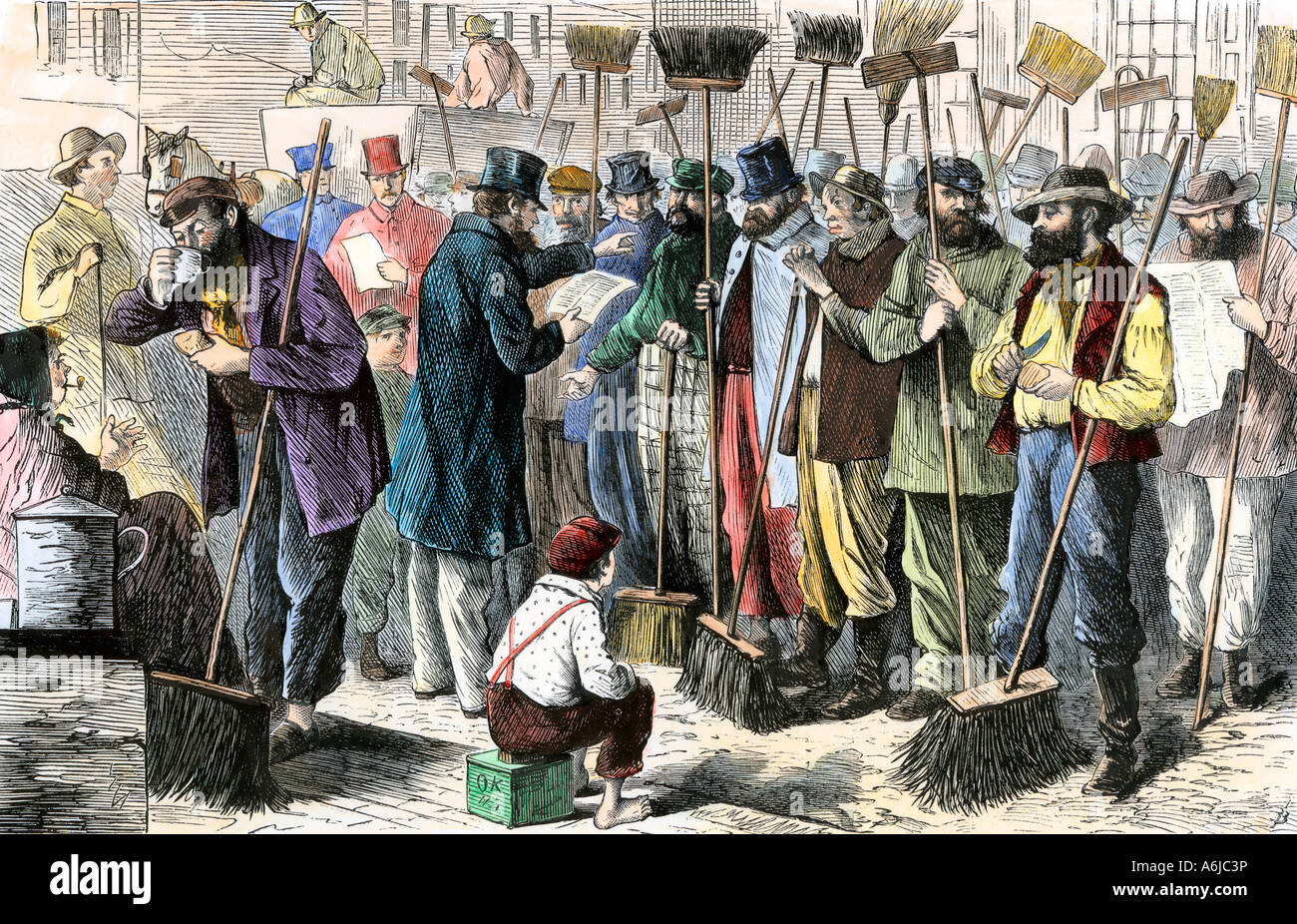 Street sweepers answering a roll call in New York City 1860s. Hand-colored woodcut Stock Photohttps://www.alamy.com/image-license-details/?v=1https://www.alamy.com/stock-photo-street-sweepers-answering-a-roll-call-in-new-york-city-1860s-hand-11588457.html
Street sweepers answering a roll call in New York City 1860s. Hand-colored woodcut Stock Photohttps://www.alamy.com/image-license-details/?v=1https://www.alamy.com/stock-photo-street-sweepers-answering-a-roll-call-in-new-york-city-1860s-hand-11588457.htmlRMA6JC3P–Street sweepers answering a roll call in New York City 1860s. Hand-colored woodcut
 French using native workers to divert the Chagres River for a Panama Canal, 1880s. Hand-colored woodcut Stock Photohttps://www.alamy.com/image-license-details/?v=1https://www.alamy.com/french-using-native-workers-to-divert-the-chagres-river-for-a-panama-canal-1880s-hand-colored-woodcut-image188779453.html
French using native workers to divert the Chagres River for a Panama Canal, 1880s. Hand-colored woodcut Stock Photohttps://www.alamy.com/image-license-details/?v=1https://www.alamy.com/french-using-native-workers-to-divert-the-chagres-river-for-a-panama-canal-1880s-hand-colored-woodcut-image188779453.htmlRMMY3J39–French using native workers to divert the Chagres River for a Panama Canal, 1880s. Hand-colored woodcut
 Going to the fields Stock Photohttps://www.alamy.com/image-license-details/?v=1https://www.alamy.com/stock-photo-going-to-the-fields-29370181.html
Going to the fields Stock Photohttps://www.alamy.com/image-license-details/?v=1https://www.alamy.com/stock-photo-going-to-the-fields-29370181.htmlRMBKNWY1–Going to the fields
 Nuttall & Co Country Store, 6495 Ware Neck Road, Gloucester Courthouse, Virginia Stock Photohttps://www.alamy.com/image-license-details/?v=1https://www.alamy.com/stock-image-nuttall-co-country-store-6495-ware-neck-road-gloucester-courthouse-162328928.html
Nuttall & Co Country Store, 6495 Ware Neck Road, Gloucester Courthouse, Virginia Stock Photohttps://www.alamy.com/image-license-details/?v=1https://www.alamy.com/stock-image-nuttall-co-country-store-6495-ware-neck-road-gloucester-courthouse-162328928.htmlRMKC2M5M–Nuttall & Co Country Store, 6495 Ware Neck Road, Gloucester Courthouse, Virginia
 Navvies (construction workers) at the Barton Aqueduct during the building of the Manchester Ship Canal, Lancashire, c.1890 Stock Photohttps://www.alamy.com/image-license-details/?v=1https://www.alamy.com/stock-photo-navvies-construction-workers-at-the-barton-aqueduct-during-the-building-79140046.html
Navvies (construction workers) at the Barton Aqueduct during the building of the Manchester Ship Canal, Lancashire, c.1890 Stock Photohttps://www.alamy.com/image-license-details/?v=1https://www.alamy.com/stock-photo-navvies-construction-workers-at-the-barton-aqueduct-during-the-building-79140046.htmlRMEGN3X6–Navvies (construction workers) at the Barton Aqueduct during the building of the Manchester Ship Canal, Lancashire, c.1890
 African Woman Kneading Dough Stock Photohttps://www.alamy.com/image-license-details/?v=1https://www.alamy.com/stock-image-african-woman-kneading-dough-168986370.html
African Woman Kneading Dough Stock Photohttps://www.alamy.com/image-license-details/?v=1https://www.alamy.com/stock-image-african-woman-kneading-dough-168986370.htmlRFKPWYRE–African Woman Kneading Dough
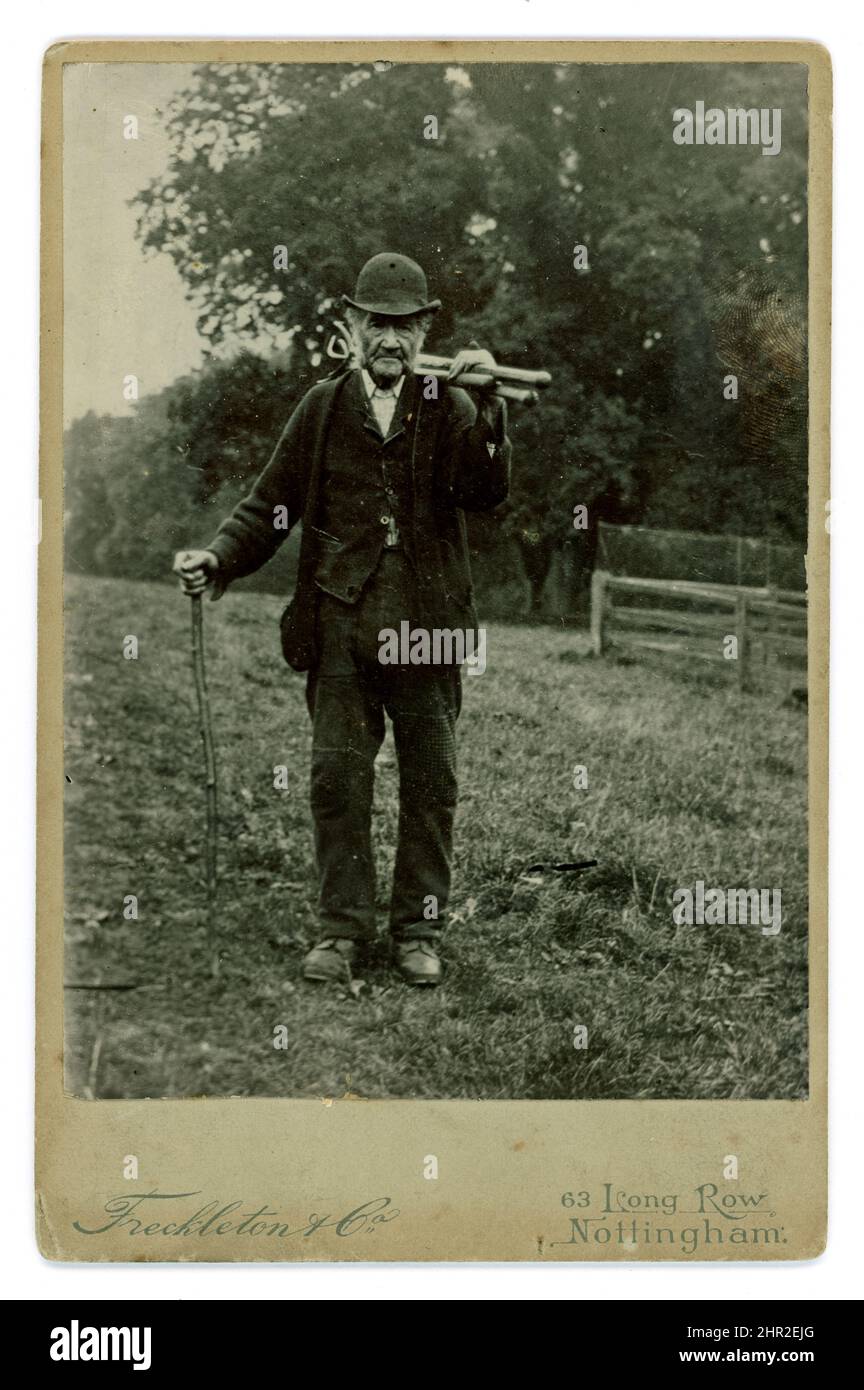 Original and rare Victorian cabinet card of poor working class older farm labourer, wearing his patched working suit, a bowler hat typical of agricultural labourers of the time, carrying farm implements, possibly hoes, rakes or billhooks. HIs looks a hard life -he is of pensioner's age. Photograph by Freckleton & Co., 63 Long Row, Nottingham, U.K. circa 1890's. Stock Photohttps://www.alamy.com/image-license-details/?v=1https://www.alamy.com/original-and-rare-victorian-cabinet-card-of-poor-working-class-older-farm-labourer-wearing-his-patched-working-suit-a-bowler-hat-typical-of-agricultural-labourers-of-the-time-carrying-farm-implements-possibly-hoes-rakes-or-billhooks-his-looks-a-hard-life-he-is-of-pensioners-age-photograph-by-freckleton-co-63-long-row-nottingham-uk-circa-1890s-image461662056.html
Original and rare Victorian cabinet card of poor working class older farm labourer, wearing his patched working suit, a bowler hat typical of agricultural labourers of the time, carrying farm implements, possibly hoes, rakes or billhooks. HIs looks a hard life -he is of pensioner's age. Photograph by Freckleton & Co., 63 Long Row, Nottingham, U.K. circa 1890's. Stock Photohttps://www.alamy.com/image-license-details/?v=1https://www.alamy.com/original-and-rare-victorian-cabinet-card-of-poor-working-class-older-farm-labourer-wearing-his-patched-working-suit-a-bowler-hat-typical-of-agricultural-labourers-of-the-time-carrying-farm-implements-possibly-hoes-rakes-or-billhooks-his-looks-a-hard-life-he-is-of-pensioners-age-photograph-by-freckleton-co-63-long-row-nottingham-uk-circa-1890s-image461662056.htmlRM2HR2EJG–Original and rare Victorian cabinet card of poor working class older farm labourer, wearing his patched working suit, a bowler hat typical of agricultural labourers of the time, carrying farm implements, possibly hoes, rakes or billhooks. HIs looks a hard life -he is of pensioner's age. Photograph by Freckleton & Co., 63 Long Row, Nottingham, U.K. circa 1890's.
 French paying native workers constructing the Panama Canal, 1880s. Hand-colored woodcut Stock Photohttps://www.alamy.com/image-license-details/?v=1https://www.alamy.com/french-paying-native-workers-constructing-the-panama-canal-1880s-hand-colored-woodcut-image188779633.html
French paying native workers constructing the Panama Canal, 1880s. Hand-colored woodcut Stock Photohttps://www.alamy.com/image-license-details/?v=1https://www.alamy.com/french-paying-native-workers-constructing-the-panama-canal-1880s-hand-colored-woodcut-image188779633.htmlRMMY3J9N–French paying native workers constructing the Panama Canal, 1880s. Hand-colored woodcut
 Worker of the Land Stock Photohttps://www.alamy.com/image-license-details/?v=1https://www.alamy.com/stock-photo-worker-of-the-land-29373316.html
Worker of the Land Stock Photohttps://www.alamy.com/image-license-details/?v=1https://www.alamy.com/stock-photo-worker-of-the-land-29373316.htmlRMBKP1Y0–Worker of the Land
 Manufacturing glass at a flint-glass factory, Great Britain, 1800s. Hand-colored woodcut Stock Photohttps://www.alamy.com/image-license-details/?v=1https://www.alamy.com/stock-photo-manufacturing-glass-at-a-flint-glass-factory-great-britain-1800s-hand-28603510.html
Manufacturing glass at a flint-glass factory, Great Britain, 1800s. Hand-colored woodcut Stock Photohttps://www.alamy.com/image-license-details/?v=1https://www.alamy.com/stock-photo-manufacturing-glass-at-a-flint-glass-factory-great-britain-1800s-hand-28603510.htmlRMBJF01X–Manufacturing glass at a flint-glass factory, Great Britain, 1800s. Hand-colored woodcut
 Nuttall & Co Country Store, 6495 Ware Neck Road, Gloucester Courthouse, Virginia Stock Photohttps://www.alamy.com/image-license-details/?v=1https://www.alamy.com/stock-image-nuttall-co-country-store-6495-ware-neck-road-gloucester-courthouse-162328927.html
Nuttall & Co Country Store, 6495 Ware Neck Road, Gloucester Courthouse, Virginia Stock Photohttps://www.alamy.com/image-license-details/?v=1https://www.alamy.com/stock-image-nuttall-co-country-store-6495-ware-neck-road-gloucester-courthouse-162328927.htmlRMKC2M5K–Nuttall & Co Country Store, 6495 Ware Neck Road, Gloucester Courthouse, Virginia
 Tarrant's Cafe, 1 West Broad Street, Richmond, Virginia Stock Photohttps://www.alamy.com/image-license-details/?v=1https://www.alamy.com/stock-photo-tarrants-cafe-1-west-broad-street-richmond-virginia-85464007.html
Tarrant's Cafe, 1 West Broad Street, Richmond, Virginia Stock Photohttps://www.alamy.com/image-license-details/?v=1https://www.alamy.com/stock-photo-tarrants-cafe-1-west-broad-street-richmond-virginia-85464007.htmlRMEY165Y–Tarrant's Cafe, 1 West Broad Street, Richmond, Virginia
 Navvies (construction workers) building the Manchester Ship Canal load waggons using a steam digger ('steam navvy') c. 1890 Stock Photohttps://www.alamy.com/image-license-details/?v=1https://www.alamy.com/stock-photo-navvies-construction-workers-building-the-manchester-ship-canal-load-77244996.html
Navvies (construction workers) building the Manchester Ship Canal load waggons using a steam digger ('steam navvy') c. 1890 Stock Photohttps://www.alamy.com/image-license-details/?v=1https://www.alamy.com/stock-photo-navvies-construction-workers-building-the-manchester-ship-canal-load-77244996.htmlRMEDJPNT–Navvies (construction workers) building the Manchester Ship Canal load waggons using a steam digger ('steam navvy') c. 1890
 Original 1890's era charming Victorian cabinet card of a farming Victorian family outside their rustic stone farmhouse or cottage. The mother wearing her Sunday best, neat hairstyle with centre parting, holds her baby / toddler girl, the father, bearded, wearing a sack coat, sits a child on his knee, who looks like a boy although wearing a girl's dress as was normal at the time. U.K. circa 1890,1891 Stock Photohttps://www.alamy.com/image-license-details/?v=1https://www.alamy.com/original-1890s-era-charming-victorian-cabinet-card-of-a-farming-victorian-family-outside-their-rustic-stone-farmhouse-or-cottage-the-mother-wearing-her-sunday-best-neat-hairstyle-with-centre-parting-holds-her-baby-toddler-girl-the-father-bearded-wearing-a-sack-coat-sits-a-child-on-his-knee-who-looks-like-a-boy-although-wearing-a-girls-dress-as-was-normal-at-the-time-uk-circa-18901891-image561947148.html
Original 1890's era charming Victorian cabinet card of a farming Victorian family outside their rustic stone farmhouse or cottage. The mother wearing her Sunday best, neat hairstyle with centre parting, holds her baby / toddler girl, the father, bearded, wearing a sack coat, sits a child on his knee, who looks like a boy although wearing a girl's dress as was normal at the time. U.K. circa 1890,1891 Stock Photohttps://www.alamy.com/image-license-details/?v=1https://www.alamy.com/original-1890s-era-charming-victorian-cabinet-card-of-a-farming-victorian-family-outside-their-rustic-stone-farmhouse-or-cottage-the-mother-wearing-her-sunday-best-neat-hairstyle-with-centre-parting-holds-her-baby-toddler-girl-the-father-bearded-wearing-a-sack-coat-sits-a-child-on-his-knee-who-looks-like-a-boy-although-wearing-a-girls-dress-as-was-normal-at-the-time-uk-circa-18901891-image561947148.htmlRM2RJ6W90–Original 1890's era charming Victorian cabinet card of a farming Victorian family outside their rustic stone farmhouse or cottage. The mother wearing her Sunday best, neat hairstyle with centre parting, holds her baby / toddler girl, the father, bearded, wearing a sack coat, sits a child on his knee, who looks like a boy although wearing a girl's dress as was normal at the time. U.K. circa 1890,1891
 Workers in a crown-glass factory, Great Britain, early 1800s. Hand-colored woodcut Stock Photohttps://www.alamy.com/image-license-details/?v=1https://www.alamy.com/stock-photo-workers-in-a-crown-glass-factory-great-britain-early-1800s-hand-colored-28604132.html
Workers in a crown-glass factory, Great Britain, early 1800s. Hand-colored woodcut Stock Photohttps://www.alamy.com/image-license-details/?v=1https://www.alamy.com/stock-photo-workers-in-a-crown-glass-factory-great-britain-early-1800s-hand-colored-28604132.htmlRMBJF0T4–Workers in a crown-glass factory, Great Britain, early 1800s. Hand-colored woodcut
 Steel-mill worker overseeing a Bessemer steel converter, 1800s. Hand-colored woodcut Stock Photohttps://www.alamy.com/image-license-details/?v=1https://www.alamy.com/stock-photo-steel-mill-worker-overseeing-a-bessemer-steel-converter-1800s-hand-58475038.html
Steel-mill worker overseeing a Bessemer steel converter, 1800s. Hand-colored woodcut Stock Photohttps://www.alamy.com/image-license-details/?v=1https://www.alamy.com/stock-photo-steel-mill-worker-overseeing-a-bessemer-steel-converter-1800s-hand-58475038.htmlRMDB3NE6–Steel-mill worker overseeing a Bessemer steel converter, 1800s. Hand-colored woodcut
 Tarrant's Cafe, 1 West Broad Street, Richmond, Virginia Stock Photohttps://www.alamy.com/image-license-details/?v=1https://www.alamy.com/stock-photo-tarrants-cafe-1-west-broad-street-richmond-virginia-85464008.html
Tarrant's Cafe, 1 West Broad Street, Richmond, Virginia Stock Photohttps://www.alamy.com/image-license-details/?v=1https://www.alamy.com/stock-photo-tarrants-cafe-1-west-broad-street-richmond-virginia-85464008.htmlRMEY1660–Tarrant's Cafe, 1 West Broad Street, Richmond, Virginia
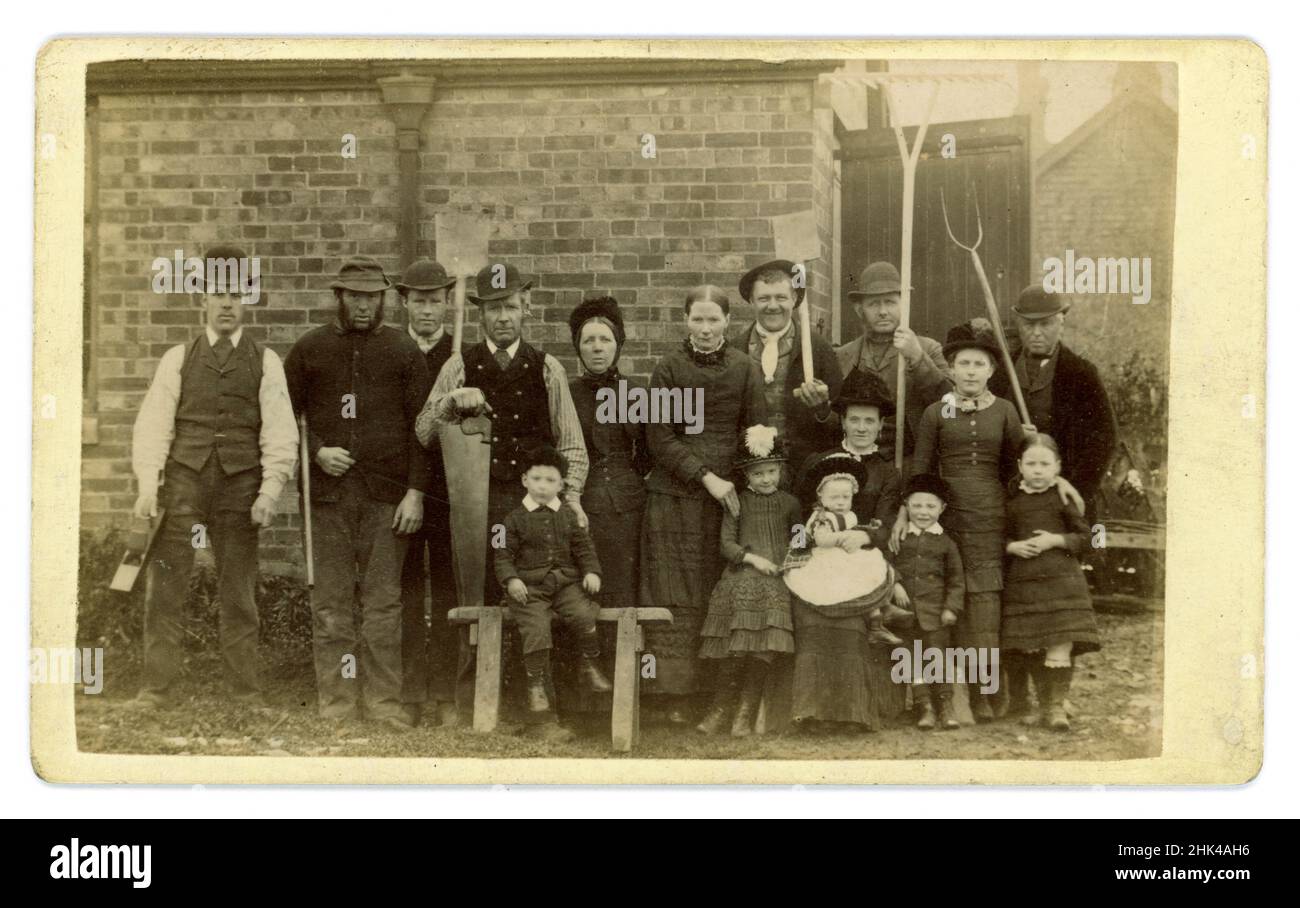 Wonderful Victorian Carte de Vistie (CDV) or visiting card of group estate workers, & their families - wives and children, several characters on Victorian farm. All are dressed in what would have been their only change of clothes - their Sunday Best. The men wear bowler hats to protect their heads. Posing for the photograph with the tools of their trade are: maintenance team with wood working tools, spade and a gun and farm hands with their agricultural tools - pitch fork, spade and rake, by the itinerant photographer A. (Alfred) Arnell of Scarborough, Yorkshire, England, U.K. circa 1880's Stock Photohttps://www.alamy.com/image-license-details/?v=1https://www.alamy.com/wonderful-victorian-carte-de-vistie-cdv-or-visiting-card-of-group-estate-workers-their-families-wives-and-children-several-characters-on-victorian-farm-all-are-dressed-in-what-would-have-been-their-only-change-of-clothes-their-sunday-best-the-men-wear-bowler-hats-to-protect-their-heads-posing-for-the-photograph-with-the-tools-of-their-trade-are-maintenance-team-with-wood-working-tools-spade-and-a-gun-and-farm-hands-with-their-agricultural-tools-pitch-fork-spade-and-rake-by-the-itinerant-photographer-a-alfred-arnell-of-scarborough-yorkshire-england-uk-circa-1880s-image459244162.html
Wonderful Victorian Carte de Vistie (CDV) or visiting card of group estate workers, & their families - wives and children, several characters on Victorian farm. All are dressed in what would have been their only change of clothes - their Sunday Best. The men wear bowler hats to protect their heads. Posing for the photograph with the tools of their trade are: maintenance team with wood working tools, spade and a gun and farm hands with their agricultural tools - pitch fork, spade and rake, by the itinerant photographer A. (Alfred) Arnell of Scarborough, Yorkshire, England, U.K. circa 1880's Stock Photohttps://www.alamy.com/image-license-details/?v=1https://www.alamy.com/wonderful-victorian-carte-de-vistie-cdv-or-visiting-card-of-group-estate-workers-their-families-wives-and-children-several-characters-on-victorian-farm-all-are-dressed-in-what-would-have-been-their-only-change-of-clothes-their-sunday-best-the-men-wear-bowler-hats-to-protect-their-heads-posing-for-the-photograph-with-the-tools-of-their-trade-are-maintenance-team-with-wood-working-tools-spade-and-a-gun-and-farm-hands-with-their-agricultural-tools-pitch-fork-spade-and-rake-by-the-itinerant-photographer-a-alfred-arnell-of-scarborough-yorkshire-england-uk-circa-1880s-image459244162.htmlRM2HK4AH6–Wonderful Victorian Carte de Vistie (CDV) or visiting card of group estate workers, & their families - wives and children, several characters on Victorian farm. All are dressed in what would have been their only change of clothes - their Sunday Best. The men wear bowler hats to protect their heads. Posing for the photograph with the tools of their trade are: maintenance team with wood working tools, spade and a gun and farm hands with their agricultural tools - pitch fork, spade and rake, by the itinerant photographer A. (Alfred) Arnell of Scarborough, Yorkshire, England, U.K. circa 1880's
 Chinese laborers working in a sugar factory in Cuba, 1872. Hand-colored woodcut Stock Photohttps://www.alamy.com/image-license-details/?v=1https://www.alamy.com/stock-photo-chinese-laborers-working-in-a-sugar-factory-in-cuba-1872-hand-colored-58525884.html
Chinese laborers working in a sugar factory in Cuba, 1872. Hand-colored woodcut Stock Photohttps://www.alamy.com/image-license-details/?v=1https://www.alamy.com/stock-photo-chinese-laborers-working-in-a-sugar-factory-in-cuba-1872-hand-colored-58525884.htmlRMDB62A4–Chinese laborers working in a sugar factory in Cuba, 1872. Hand-colored woodcut
 Original Victorian CDV of 3 Wigan (Lancashire) pit brow girls, wearing working clothes, including trousers with shovels and sieves, working tools. Photo by Herbert Wragg of Wigan (printed on front of photograph) & reproduced by A. & G. Taylor, 34 Church St. Liverpool, U.K. circa 1885 Stock Photohttps://www.alamy.com/image-license-details/?v=1https://www.alamy.com/original-victorian-cdv-of-3-wigan-lancashire-pit-brow-girls-wearing-working-clothes-including-trousers-with-shovels-and-sieves-working-tools-photo-by-herbert-wragg-of-wigan-printed-on-front-of-photograph-reproduced-by-a-g-taylor-34-church-st-liverpool-uk-circa-1885-image449187083.html
Original Victorian CDV of 3 Wigan (Lancashire) pit brow girls, wearing working clothes, including trousers with shovels and sieves, working tools. Photo by Herbert Wragg of Wigan (printed on front of photograph) & reproduced by A. & G. Taylor, 34 Church St. Liverpool, U.K. circa 1885 Stock Photohttps://www.alamy.com/image-license-details/?v=1https://www.alamy.com/original-victorian-cdv-of-3-wigan-lancashire-pit-brow-girls-wearing-working-clothes-including-trousers-with-shovels-and-sieves-working-tools-photo-by-herbert-wragg-of-wigan-printed-on-front-of-photograph-reproduced-by-a-g-taylor-34-church-st-liverpool-uk-circa-1885-image449187083.htmlRM2H2P6KR–Original Victorian CDV of 3 Wigan (Lancashire) pit brow girls, wearing working clothes, including trousers with shovels and sieves, working tools. Photo by Herbert Wragg of Wigan (printed on front of photograph) & reproduced by A. & G. Taylor, 34 Church St. Liverpool, U.K. circa 1885
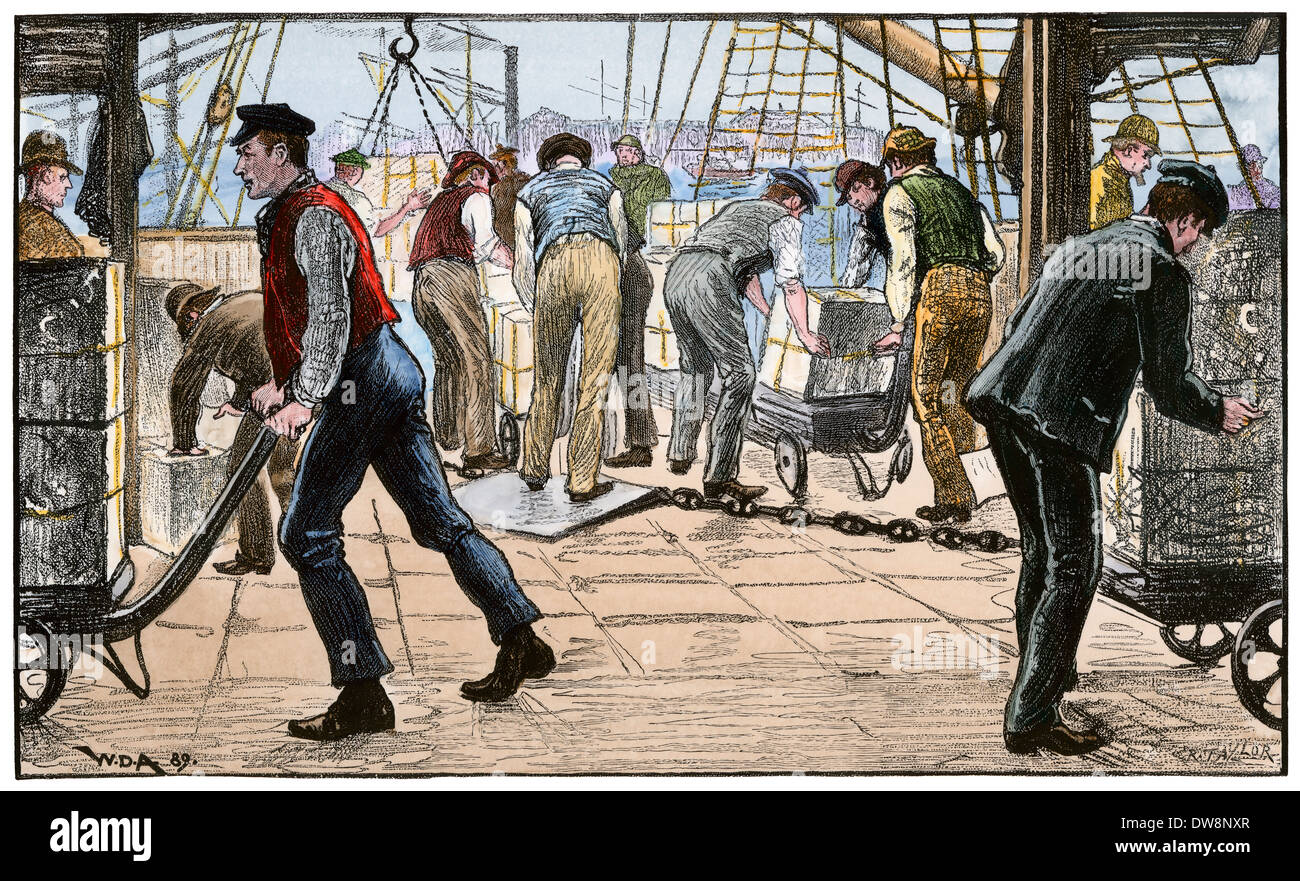 Dockers unloading a cargo of tea, London, 1880s. Hand-colored woodcut Stock Photohttps://www.alamy.com/image-license-details/?v=1https://www.alamy.com/dockers-unloading-a-cargo-of-tea-london-1880s-hand-colored-woodcut-image67190335.html
Dockers unloading a cargo of tea, London, 1880s. Hand-colored woodcut Stock Photohttps://www.alamy.com/image-license-details/?v=1https://www.alamy.com/dockers-unloading-a-cargo-of-tea-london-1880s-hand-colored-woodcut-image67190335.htmlRMDW8NXR–Dockers unloading a cargo of tea, London, 1880s. Hand-colored woodcut
 Original Victorian cabinet card cards of group of fishermen / traders / porters, characters / characterful, outside the fish merchants of J.E. Borlace, with catch of fish, including a skate held up by one man, and a hand cart with wrapped produce, barrels advertising merchant's name, at the quayside, coastal fishing port of Brixham, Torbay district, Devon, U.K. By photographer Peth K. Kitto (maybe Frederick K ) circa 1890's. Stock Photohttps://www.alamy.com/image-license-details/?v=1https://www.alamy.com/original-victorian-cabinet-card-cards-of-group-of-fishermen-traders-porters-characters-characterful-outside-the-fish-merchants-of-je-borlace-with-catch-of-fish-including-a-skate-held-up-by-one-man-and-a-hand-cart-with-wrapped-produce-barrels-advertising-merchants-name-at-the-quayside-coastal-fishing-port-of-brixham-torbay-district-devon-uk-by-photographer-peth-k-kitto-maybe-frederick-k-circa-1890s-image511430060.html
Original Victorian cabinet card cards of group of fishermen / traders / porters, characters / characterful, outside the fish merchants of J.E. Borlace, with catch of fish, including a skate held up by one man, and a hand cart with wrapped produce, barrels advertising merchant's name, at the quayside, coastal fishing port of Brixham, Torbay district, Devon, U.K. By photographer Peth K. Kitto (maybe Frederick K ) circa 1890's. Stock Photohttps://www.alamy.com/image-license-details/?v=1https://www.alamy.com/original-victorian-cabinet-card-cards-of-group-of-fishermen-traders-porters-characters-characterful-outside-the-fish-merchants-of-je-borlace-with-catch-of-fish-including-a-skate-held-up-by-one-man-and-a-hand-cart-with-wrapped-produce-barrels-advertising-merchants-name-at-the-quayside-coastal-fishing-port-of-brixham-torbay-district-devon-uk-by-photographer-peth-k-kitto-maybe-frederick-k-circa-1890s-image511430060.htmlRM2MM1J78–Original Victorian cabinet card cards of group of fishermen / traders / porters, characters / characterful, outside the fish merchants of J.E. Borlace, with catch of fish, including a skate held up by one man, and a hand cart with wrapped produce, barrels advertising merchant's name, at the quayside, coastal fishing port of Brixham, Torbay district, Devon, U.K. By photographer Peth K. Kitto (maybe Frederick K ) circa 1890's.
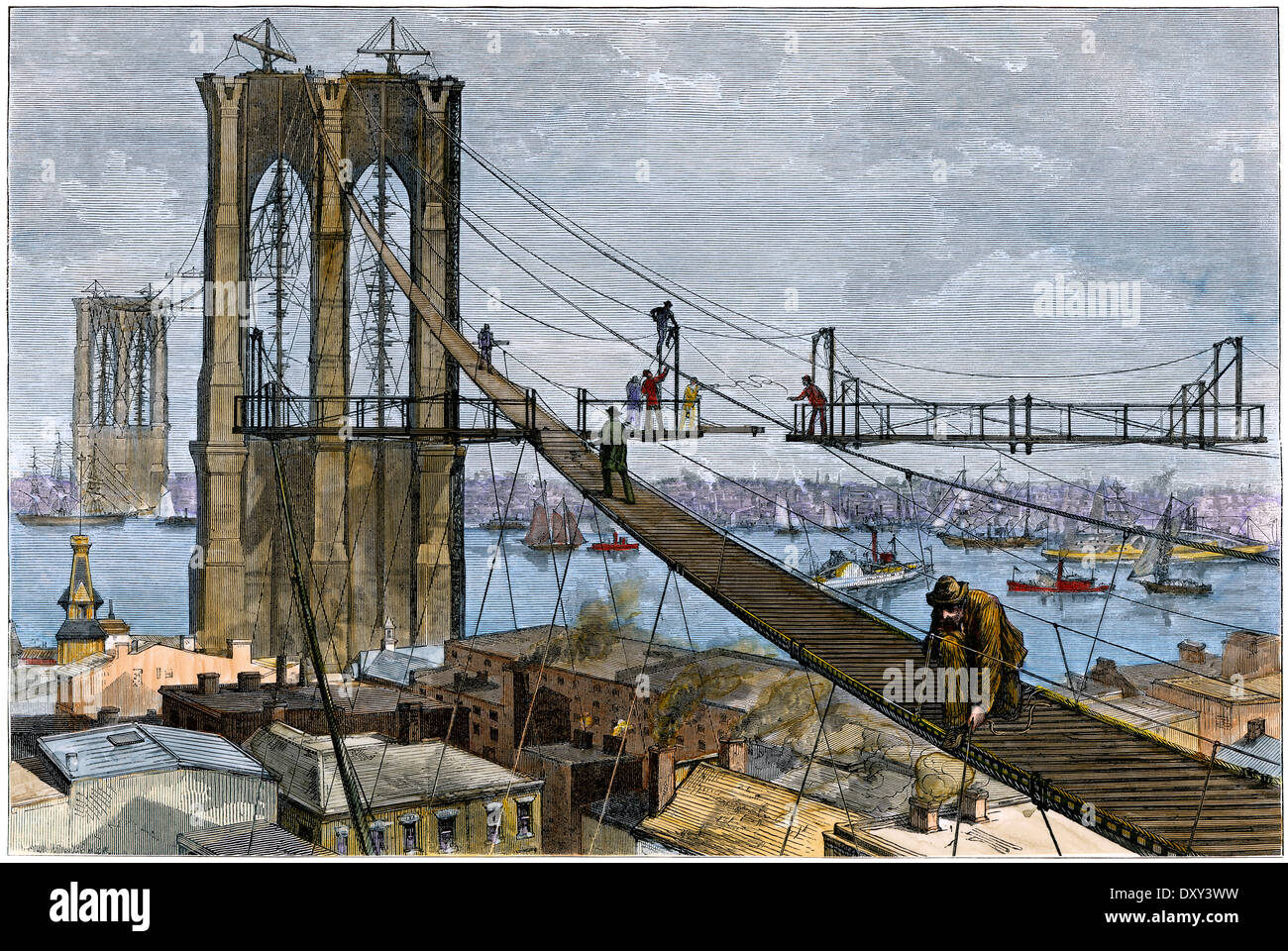 Workmen ascending a mid-air ramp to construct Brooklyn Bridge towers, New York NY, 1870s. Hand-colored woodcut Stock Photohttps://www.alamy.com/image-license-details/?v=1https://www.alamy.com/workmen-ascending-a-mid-air-ramp-to-construct-brooklyn-bridge-towers-image68207941.html
Workmen ascending a mid-air ramp to construct Brooklyn Bridge towers, New York NY, 1870s. Hand-colored woodcut Stock Photohttps://www.alamy.com/image-license-details/?v=1https://www.alamy.com/workmen-ascending-a-mid-air-ramp-to-construct-brooklyn-bridge-towers-image68207941.htmlRMDXY3WW–Workmen ascending a mid-air ramp to construct Brooklyn Bridge towers, New York NY, 1870s. Hand-colored woodcut
 Original sepia toned Victorian CDV (Carte de Visite) portrait of pit brow girls (broo lasses or wenches) wearing clogs and trousers under their aprons, posing with the tools of their trade - a shovel and sieve. They worked on the pit bank (or brow) at the shaft top picking stones out of the coal, on the coalfield, photographed by John Cooper's studio, Wigan, Greater Manchester, Lancashire, U.K. circa 1870 Stock Photohttps://www.alamy.com/image-license-details/?v=1https://www.alamy.com/original-sepia-toned-victorian-cdv-carte-de-visite-portrait-of-pit-brow-girls-broo-lasses-or-wenches-wearing-clogs-and-trousers-under-their-aprons-posing-with-the-tools-of-their-trade-a-shovel-and-sieve-they-worked-on-the-pit-bank-or-brow-at-the-shaft-top-picking-stones-out-of-the-coal-on-the-coalfield-photographed-by-john-coopers-studio-wigan-greater-manchester-lancashire-uk-circa-1870-image258765356.html
Original sepia toned Victorian CDV (Carte de Visite) portrait of pit brow girls (broo lasses or wenches) wearing clogs and trousers under their aprons, posing with the tools of their trade - a shovel and sieve. They worked on the pit bank (or brow) at the shaft top picking stones out of the coal, on the coalfield, photographed by John Cooper's studio, Wigan, Greater Manchester, Lancashire, U.K. circa 1870 Stock Photohttps://www.alamy.com/image-license-details/?v=1https://www.alamy.com/original-sepia-toned-victorian-cdv-carte-de-visite-portrait-of-pit-brow-girls-broo-lasses-or-wenches-wearing-clogs-and-trousers-under-their-aprons-posing-with-the-tools-of-their-trade-a-shovel-and-sieve-they-worked-on-the-pit-bank-or-brow-at-the-shaft-top-picking-stones-out-of-the-coal-on-the-coalfield-photographed-by-john-coopers-studio-wigan-greater-manchester-lancashire-uk-circa-1870-image258765356.htmlRMW0YNRT–Original sepia toned Victorian CDV (Carte de Visite) portrait of pit brow girls (broo lasses or wenches) wearing clogs and trousers under their aprons, posing with the tools of their trade - a shovel and sieve. They worked on the pit bank (or brow) at the shaft top picking stones out of the coal, on the coalfield, photographed by John Cooper's studio, Wigan, Greater Manchester, Lancashire, U.K. circa 1870
 Original Victorian studio portrait printed as a souvenir postcard of Pit Brow girls and Screen Lasses with tools of trade, posted June 9th 1908 but photographed in 1887 by Herbert Wragg at an unknown coalfield in Wigan, Lancashire, England, U.K. Stock Photohttps://www.alamy.com/image-license-details/?v=1https://www.alamy.com/original-victorian-studio-portrait-printed-as-a-souvenir-postcard-of-pit-brow-girls-and-screen-lasses-with-tools-of-trade-posted-june-9th-1908-but-photographed-in-1887-by-herbert-wragg-at-an-unknown-coalfield-in-wigan-lancashire-england-uk-image559472484.html
Original Victorian studio portrait printed as a souvenir postcard of Pit Brow girls and Screen Lasses with tools of trade, posted June 9th 1908 but photographed in 1887 by Herbert Wragg at an unknown coalfield in Wigan, Lancashire, England, U.K. Stock Photohttps://www.alamy.com/image-license-details/?v=1https://www.alamy.com/original-victorian-studio-portrait-printed-as-a-souvenir-postcard-of-pit-brow-girls-and-screen-lasses-with-tools-of-trade-posted-june-9th-1908-but-photographed-in-1887-by-herbert-wragg-at-an-unknown-coalfield-in-wigan-lancashire-england-uk-image559472484.htmlRM2RE64T4–Original Victorian studio portrait printed as a souvenir postcard of Pit Brow girls and Screen Lasses with tools of trade, posted June 9th 1908 but photographed in 1887 by Herbert Wragg at an unknown coalfield in Wigan, Lancashire, England, U.K.
 Original sepia-toned Victorian era cabinet card relaxed outdoor portrait of large group of working class men and boys (apprenticed maybe) sitting near an ancient harbour wall near a slipway. They are all wearing peaked mariners caps, and some are wearing hand knitted fishermen's sweaters, another an apron, and are probably in the fishing industry - a coastal seafaring fishing community in the U.K. Dated June 1892. Stock Photohttps://www.alamy.com/image-license-details/?v=1https://www.alamy.com/original-sepia-toned-victorian-era-cabinet-card-relaxed-outdoor-portrait-of-large-group-of-working-class-men-and-boys-apprenticed-maybe-sitting-near-an-ancient-harbour-wall-near-a-slipway-they-are-all-wearing-peaked-mariners-caps-and-some-are-wearing-hand-knitted-fishermens-sweaters-another-an-apron-and-are-probably-in-the-fishing-industry-a-coastal-seafaring-fishing-community-in-the-uk-dated-june-1892-image463339752.html
Original sepia-toned Victorian era cabinet card relaxed outdoor portrait of large group of working class men and boys (apprenticed maybe) sitting near an ancient harbour wall near a slipway. They are all wearing peaked mariners caps, and some are wearing hand knitted fishermen's sweaters, another an apron, and are probably in the fishing industry - a coastal seafaring fishing community in the U.K. Dated June 1892. Stock Photohttps://www.alamy.com/image-license-details/?v=1https://www.alamy.com/original-sepia-toned-victorian-era-cabinet-card-relaxed-outdoor-portrait-of-large-group-of-working-class-men-and-boys-apprenticed-maybe-sitting-near-an-ancient-harbour-wall-near-a-slipway-they-are-all-wearing-peaked-mariners-caps-and-some-are-wearing-hand-knitted-fishermens-sweaters-another-an-apron-and-are-probably-in-the-fishing-industry-a-coastal-seafaring-fishing-community-in-the-uk-dated-june-1892-image463339752.htmlRM2HWPXG8–Original sepia-toned Victorian era cabinet card relaxed outdoor portrait of large group of working class men and boys (apprenticed maybe) sitting near an ancient harbour wall near a slipway. They are all wearing peaked mariners caps, and some are wearing hand knitted fishermen's sweaters, another an apron, and are probably in the fishing industry - a coastal seafaring fishing community in the U.K. Dated June 1892.
 Original and rare Victorian Carte de Visite (Visiting Card or CDV) of a group of wheelwrights posing for a photograph in front of a carriage, holding tools, callipers, one man with an axe is making a new wooden spoke. unknown location in U.K. square mount indicates 1860's. Stock Photohttps://www.alamy.com/image-license-details/?v=1https://www.alamy.com/original-and-rare-victorian-carte-de-visite-visiting-card-or-cdv-of-a-group-of-wheelwrights-posing-for-a-photograph-in-front-of-a-carriage-holding-tools-callipers-one-man-with-an-axe-is-making-a-new-wooden-spoke-unknown-location-in-uk-square-mount-indicates-1860s-image471946201.html
Original and rare Victorian Carte de Visite (Visiting Card or CDV) of a group of wheelwrights posing for a photograph in front of a carriage, holding tools, callipers, one man with an axe is making a new wooden spoke. unknown location in U.K. square mount indicates 1860's. Stock Photohttps://www.alamy.com/image-license-details/?v=1https://www.alamy.com/original-and-rare-victorian-carte-de-visite-visiting-card-or-cdv-of-a-group-of-wheelwrights-posing-for-a-photograph-in-front-of-a-carriage-holding-tools-callipers-one-man-with-an-axe-is-making-a-new-wooden-spoke-unknown-location-in-uk-square-mount-indicates-1860s-image471946201.htmlRM2JBR05D–Original and rare Victorian Carte de Visite (Visiting Card or CDV) of a group of wheelwrights posing for a photograph in front of a carriage, holding tools, callipers, one man with an axe is making a new wooden spoke. unknown location in U.K. square mount indicates 1860's.
 Boys selling pretzels on a sidewalk in New York City, 1890s. Hand-colored woodcut Stock Photohttps://www.alamy.com/image-license-details/?v=1https://www.alamy.com/stock-photo-boys-selling-pretzels-on-a-sidewalk-in-new-york-city-1890s-hand-colored-58475078.html
Boys selling pretzels on a sidewalk in New York City, 1890s. Hand-colored woodcut Stock Photohttps://www.alamy.com/image-license-details/?v=1https://www.alamy.com/stock-photo-boys-selling-pretzels-on-a-sidewalk-in-new-york-city-1890s-hand-colored-58475078.htmlRMDB3NFJ–Boys selling pretzels on a sidewalk in New York City, 1890s. Hand-colored woodcut
 Anxious families waiting for news after a coal mine explosion in Staffordshire, England, 1880s. Hand-colored woodcut Stock Photohttps://www.alamy.com/image-license-details/?v=1https://www.alamy.com/anxious-families-waiting-for-news-after-a-coal-mine-explosion-in-staffordshire-image67190384.html
Anxious families waiting for news after a coal mine explosion in Staffordshire, England, 1880s. Hand-colored woodcut Stock Photohttps://www.alamy.com/image-license-details/?v=1https://www.alamy.com/anxious-families-waiting-for-news-after-a-coal-mine-explosion-in-staffordshire-image67190384.htmlRMDW8P0G–Anxious families waiting for news after a coal mine explosion in Staffordshire, England, 1880s. Hand-colored woodcut
 Transcontinental railroad workers' camp at Echo City, Utah, terminus of the Union Pacific RR, 1860s. Hand-colored woodcut Stock Photohttps://www.alamy.com/image-license-details/?v=1https://www.alamy.com/transcontinental-railroad-workers-camp-at-echo-city-utah-terminus-image60939284.html
Transcontinental railroad workers' camp at Echo City, Utah, terminus of the Union Pacific RR, 1860s. Hand-colored woodcut Stock Photohttps://www.alamy.com/image-license-details/?v=1https://www.alamy.com/transcontinental-railroad-workers-camp-at-echo-city-utah-terminus-image60939284.htmlRMDF40K0–Transcontinental railroad workers' camp at Echo City, Utah, terminus of the Union Pacific RR, 1860s. Hand-colored woodcut
 Last spike driven for the transcontinental railroad in Utah, 1869. Hand-colored woodcut Stock Photohttps://www.alamy.com/image-license-details/?v=1https://www.alamy.com/last-spike-driven-for-the-transcontinental-railroad-in-utah-1869-hand-image67583262.html
Last spike driven for the transcontinental railroad in Utah, 1869. Hand-colored woodcut Stock Photohttps://www.alamy.com/image-license-details/?v=1https://www.alamy.com/last-spike-driven-for-the-transcontinental-railroad-in-utah-1869-hand-image67583262.htmlRMDWXK3X–Last spike driven for the transcontinental railroad in Utah, 1869. Hand-colored woodcut
 The builder--a worker constructing the great cities of America, circa 1900. Color halftone of a Gerrit A. Beneker illustration Stock Photohttps://www.alamy.com/image-license-details/?v=1https://www.alamy.com/the-builder-a-worker-constructing-the-great-cities-of-america-circa-1900-color-halftone-of-a-gerrit-a-beneker-illustration-image255647392.html
The builder--a worker constructing the great cities of America, circa 1900. Color halftone of a Gerrit A. Beneker illustration Stock Photohttps://www.alamy.com/image-license-details/?v=1https://www.alamy.com/the-builder-a-worker-constructing-the-great-cities-of-america-circa-1900-color-halftone-of-a-gerrit-a-beneker-illustration-image255647392.htmlRMTRWMT0–The builder--a worker constructing the great cities of America, circa 1900. Color halftone of a Gerrit A. Beneker illustration